UNESCO
Protecting biodiversity is sharing humanity
Biodiversity
- Lisbeth
- Site Admin
- Posts: 67563
- Joined: Sat May 19, 2012 12:31 pm
- Country: Switzerland
- Location: Lugano
- Contact:
Re: Biodiversity
"Education is the most powerful weapon which you can use to change the world." Nelson Mandela
The desire for equality must never exceed the demands of knowledge
The desire for equality must never exceed the demands of knowledge
- Lisbeth
- Site Admin
- Posts: 67563
- Joined: Sat May 19, 2012 12:31 pm
- Country: Switzerland
- Location: Lugano
- Contact:
Re: Biodiversity

21 April 2023
The Endangered Wildlife Trust (EWT), in collaboration with the Wildlife and Environment Society of South Africa (WESSA), recently assessed the state of South Africa’s provincial nature reserves (PRs) in terms of management effectiveness. The country’s municipal and provincial reserves cover just over three million hectares and are protected for their intended contribution to South Africa’s economic, ecosystem services, and biodiversity value. However, there is growing concern that South African PRs, which contain high biological diversity and threatened ecosystems, are not fulfilling their conservation objectives. The report’s findings detail the challenges affecting management efficacy in some of the most biodiverse reserves, identify opportunities to address these challenges, and in some cases, suggest urgent management interventions required to realise the potential of these national assets.
South Africa is one of the most biologically diverse countries in the world and is home to at least 87,000 species of plants and animals, yet habitat degradation, invasive alien species, illegal wildlife trade, pollution, climate change, human-wildlife conflict, and more threaten these species and human survival and prosperity. Properly functioning protected areas offer safe havens for South Africa’s unique biodiversity and are crucial for the long-term survival of our wildlife and ecosystems and human wellbeing. Enshrined in the South African constitution is a right to a healthy environment, protected through legislation and other measures to benefit present and future generations. Therefore, the sound management of South Africa’s provincial reserves forms part of our constitutional rights and our country’s commitments to the targets set under the Global Framework to conserve 30% of land and marine areas by 2030.
With 427 individual reserves, the protected area estate in South Africa under provincial management is significant, but the question that this report aims to answer is whether the current standard of management of these reserves is effective for the conservation of critical biodiversity. To answer this question, the State of Provincial Reserves in South Africa Report was produced using several tools, including analysis of the Management Effectiveness Tracking Tool (METT-SA) reports, online surveys with conservation experts, and interviews with reserve managers, conservation practitioners, and relevant non-government representatives.
“The state of provincial reserves varies from province to province; hence they cannot all be painted with the same brush. Financial and human resources, coupled with a skilled and committed workforce, are critical ingredients for the success of any Provincial Nature Reserve.”
Survey respondent.
Alarmingly, findings showed that several South African provincial reserves with high-scoring conservation value are not being managed effectively. The report reveals a lack of critical skills and capacity, poor management implementation, and inadequate budgets as the three key challenges impacting the effective management of these reserves. Opportunities to address these challenges and key recommendations on how to turn the tide on the state of our provincial reserves are outlined in this publication. These include building staff capacity and ensuring experienced managers are appointed, refurbishing poorly-maintained infrastructure to develop the tourism potential of the PRs, and encouraging partnerships and collaborations with the private sector, NGOs, and communities to catalyse opportunities for income generation and mutually beneficial relationships between PRs and local communities.
South Africa has committed, in principle, to the Kunming-Montreal Global Biodiversity Framework (GBF), within which is the ambitious, so-called ‘30x30’ target. This target aims to ensure that 30 percent of terrestrial and marine areas are formally protected by 2030. Provincial reserves have the potential to contribute significantly to this target but cannot be allowed to become what is termed “paper parks”, meaning that they exist as areas of conservation protection on paper only. This report highlights opportunities to turn the state of our provincial reserves around and the risks associated with allowing the decline in their status to continue. PRs are a fundamental tool for conserving biodiversity and undoubtedly play an essential role in stemming the current and alarming decline in species and the ongoing degradation of natural habitats. Without these reserves, our wildlife populations will disappear, and the ecosystems we rely on for basic services will no longer function, leading to catastrophic risks to human health and an inability to withstand the effects of climate change.
Endangered Wildlife Trust contacts:
Dr Ian Little
EWT’s Head of Conservation
ianl@ewt.org.za
Emily Taylor
EWT Communications Manager
Emilyt@ewt.org.za
"Education is the most powerful weapon which you can use to change the world." Nelson Mandela
The desire for equality must never exceed the demands of knowledge
The desire for equality must never exceed the demands of knowledge
- Lisbeth
- Site Admin
- Posts: 67563
- Joined: Sat May 19, 2012 12:31 pm
- Country: Switzerland
- Location: Lugano
- Contact:
Re: Biodiversity
Rewilding Africa the tough way — lessons from Majete in Malawi
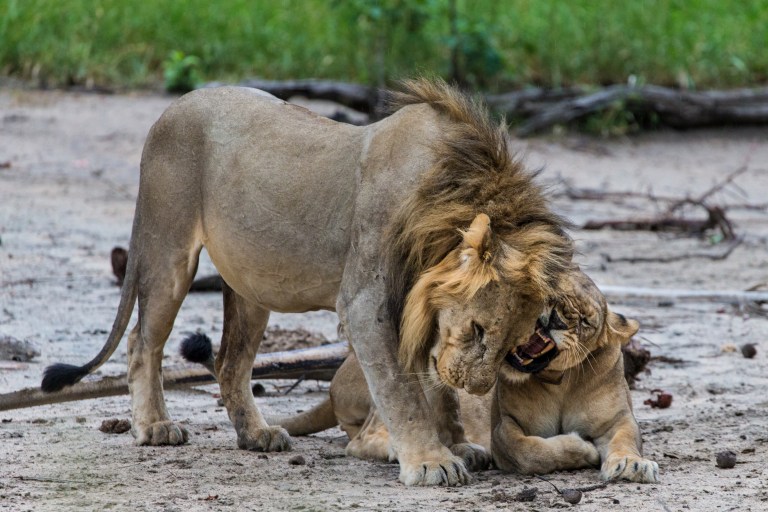
After their extirpation over 20 years ago lions are back in Majete. Photo: Marcus Westberg
By Don Pinnock | 17 Aug 2023
To conserve Earth’s biodiversity, the Global Deal for Nature calculated it would be necessary to protect 30% of the land and seas. Is that possible in Africa? A savvy conservation NGO has drawn up an African game plan that began with a single reserve.
___________________________________________________________________________________________________________________________
The message from Majete Wildlife Reserve in southern Malawi is that ecosystems in Africa can be rewilded, but only with intense human intervention.
Twenty years ago, the reserve was degraded land. Its animals had been poached to a few jittery kudu, waterbuck and warthogs, its ancient woodlands rendered to charcoal.
Today it’s been fully rewilded, with elephant, black rhino, lion, leopard, buffalo, wild dogs and many species of antelope. It is home to more than 300 species of birds and their dawn chorus is almost deafening.
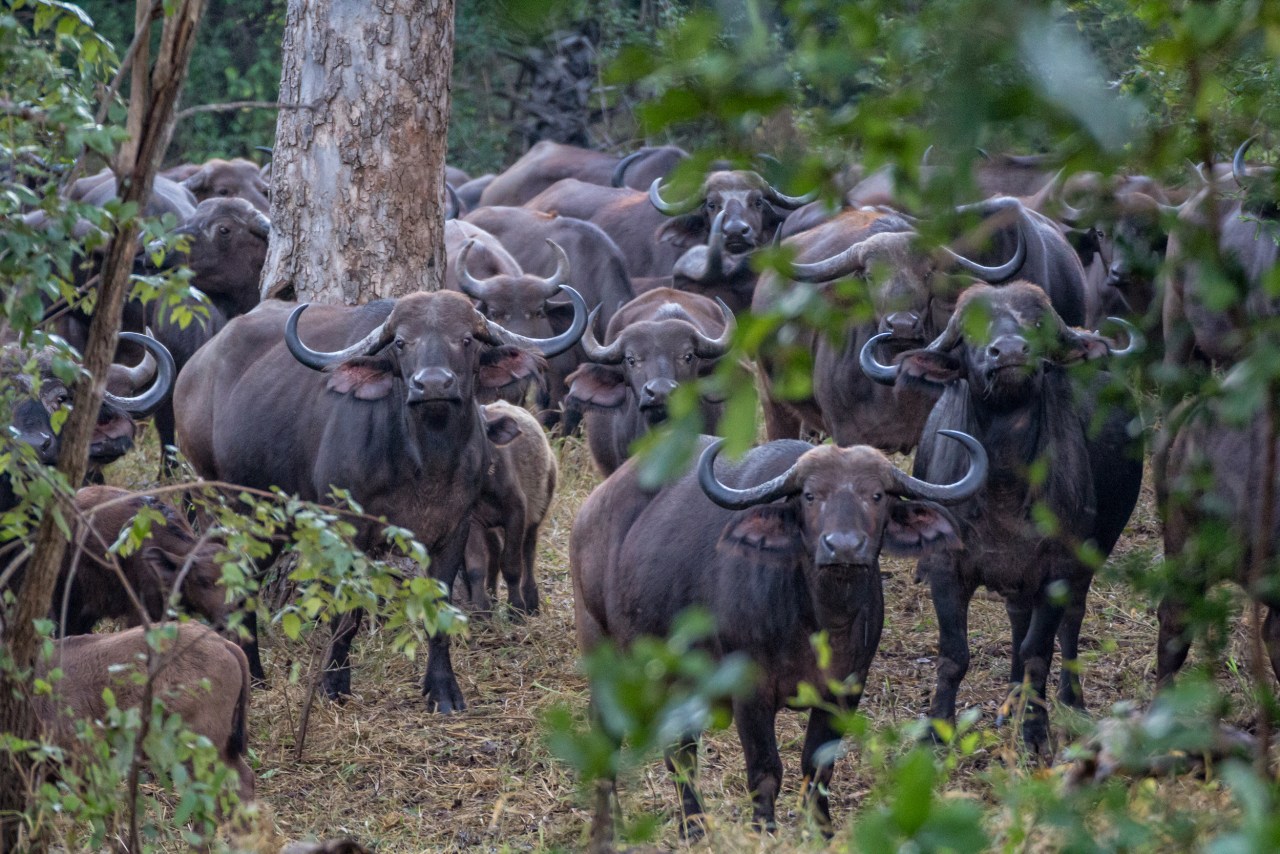
Since their reintroduction, Majete’s buffalo herds have flourished. (Photo: John Dickens)
Giant trees line the streams and the Shire River, which flows along its boundary. A waterhole just beyond the lodge veranda presents extraordinary sightings of animals no longer wary of humans.
But the process necessary to arrive here required a rethink of the notion of rewilding, which traditionally focuses on “replacing human interventions with natural processes… to create resilient, self-regulating and self-sustaining ecosystems”.
On a continent with the world’s fastest-growing population, stepping back to allow nature to restore itself is simply not an option. That’s what Majete taught African Parks (AP), which manages the reserve. To rewild in Africa you need intense management on both sides of the fence.
Looking after what is outside the fence
In the past, the model for park management had always been to look after what’s inside the fence. The AP approach is to also look after who’s outside it. It’s become a model for what rewilding requires to conserve wildlife on the continent.
“I know a lot of people are scathing about fences,” says Majete Park Manager John Adendorff, but if you have human-animal conflict, you have massive problems. Your reserve is dead in the water.
“We had to draw a line in the sand and say, this is park, that is community land, and we put up a fence. Then we worked on either side of it to make sure the benefits flowed in both directions.”
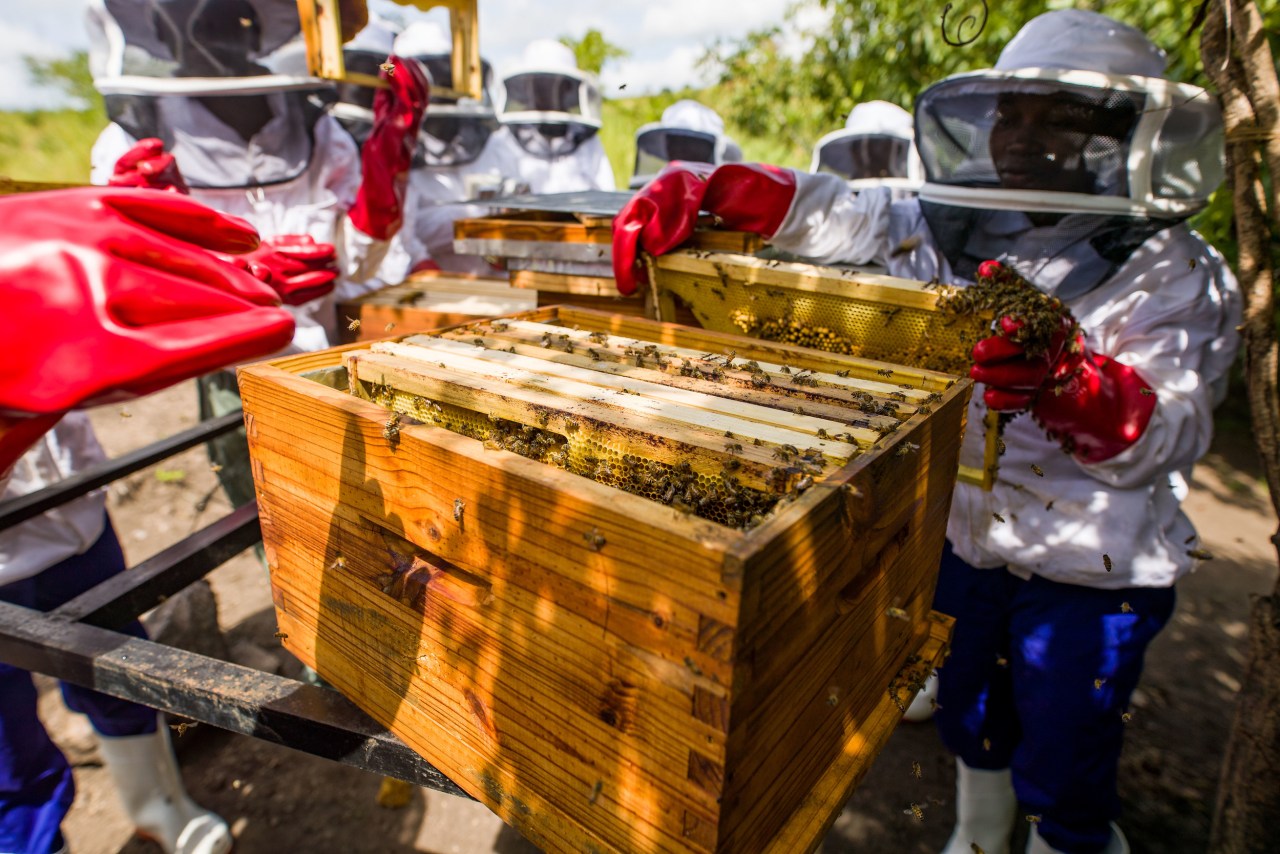
Bee Harvesting at Mejete has been a lifeline for many people in villages surrounding the park (Photo: Heunis Naude)
Community Extension Manager Dixie Makwale took me down a bumpy track outside the park fence to show what that meant. We stopped at a centre built by AP that contained a clinic, creche, community grain store, maize mill, community bank and honey processing workshop. There’s electricity and free WiFi access.
“There was nothing here,” a woman in a brightly coloured kanga told me, indicating the buildings. “Now I’m a beekeeper. Honey paid for my house with a good roof and kept my children in school. My husband is also a beekeeper, but I have more hives than him. And we have a clinic.”
Dixie explained: “There are six of these centres – we call them epicentres – around the park. They’re in the six traditional authorities surrounding Majete. It’s incredibly important to respect these authorities. They’ve been there for thousands of years.
“They all come together as the Majete Wildlife Reserve Association to discuss the way forward and how to improve things. There’s a sense of ownership, they’re our conservation ambassadors. It’s about building real and emotional ownership.
“Also, along the Shire River there are fish farms and a central nursery provided up to 90,000 trees a year for the community to plant.”
Adendorff is understanding about why the park was degraded before AP took over. “Malawi is the third poorest country in Africa,” he said. “We can’t blame people for cutting down trees to sell as charcoal, it’s one of their main sources of income. But we can help them replant. We have to create sustainable enterprises.
“We also have to get kids to understand the value of wildlife. It’s no longer part of their cultural landscape. So we bring neighbouring youngsters into the park, house them in tents and tell stories around the fire at night. And we provide educational scholarships.”
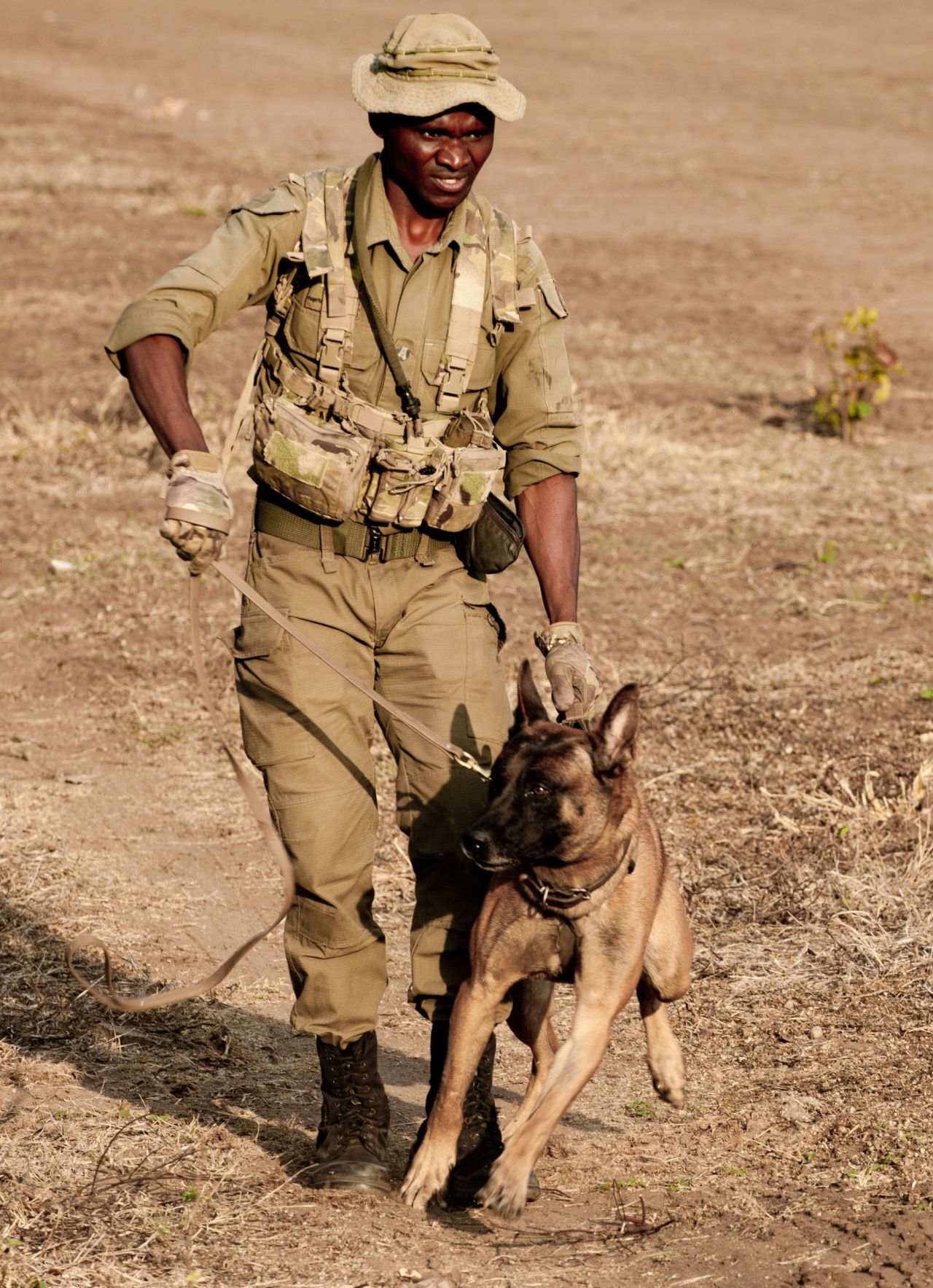
Gile the tracker malinois and handler at Majete. (Photo: Don Pinnock)
Dogs and more
Gaining community support for the park is half the battle, managing it is the other half. In that, AP has plenty of experience, administering 22 parks in 12 countries across Africa. Majete was its first, and its training ground.
The reserve has tracker dogs and 44 highly trained and armed rangers who monitor rhinos every day, both on foot and electronically.
In a demonstration of the dogs’ ability, a suitably padded volunteer was tracked by Gile and Milo, a Belgian malinois and a Dutch shepherd. Gile hit the “poacher” so hard when it found him that he was rolled and held down.
Dog trainer Bright Maondo laughed when I asked if he’d had to take down poachers like that. “We never have to,” he said. “We do that demonstration in areas surrounding the reserve and almost nobody has jumped the fence.”
I wouldn’t either, after seeing what a trained dog can do.
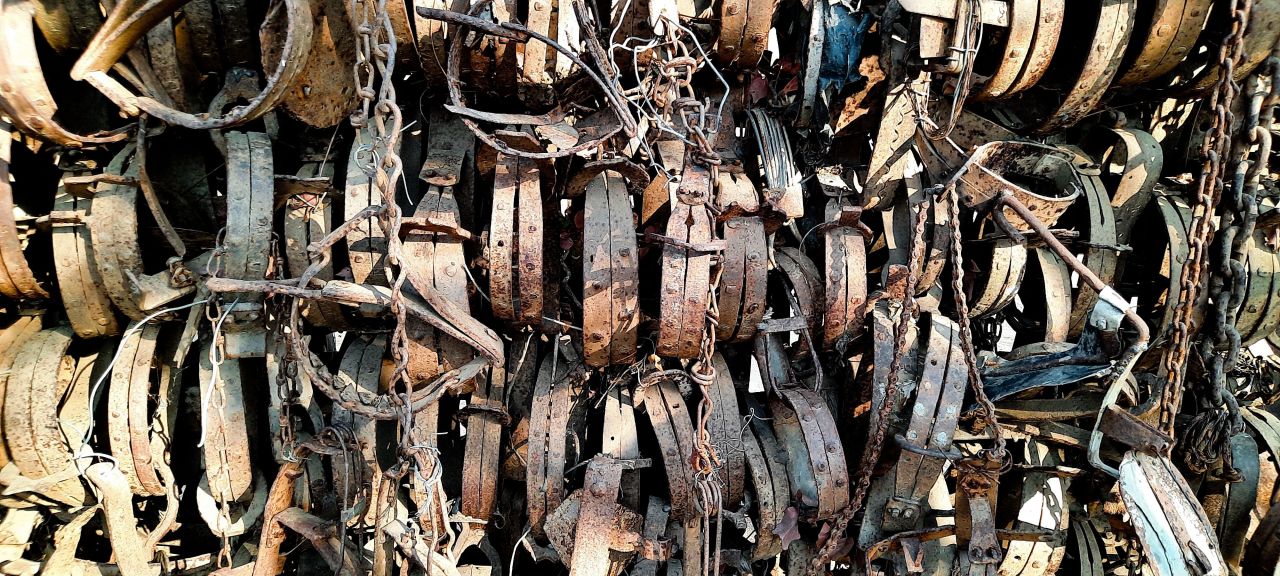
Traps confiscated in Majete. (Photo: Don Pinnock)
Database tracking
Each day, beginning before sunrise, rangers are out tracking the park’s black rhinos. They report their location, photograph them and check their condition. All this goes into a database which, combined with satellite collars on a range of animals, makes it possible for Majete’s wildlife monitoring team to survey the reserve in real time.
Ongoing animal activity is projected on a screen, giving a detailed birds-eye view of who and where animals are and what they’re up to. Majete may be rewilded, but it’s very carefully watched.
“Any closed system with a growing population needs to be managed,” explained Adendorff. “Almost all mammals here were brought in. Protected, populations grow. We have to manage that. Law enforcement is essential, as is never becoming complacent.
“When I worked in conservation in South Africa, we thought we were the best and we protected everything. Now rhino destruction there is huge and they’re not able to get on top of it. That taught us here at Majete to be pre-emptive rather than reactive. The surrounding communities are part of that. If a syndicate tries to infiltrate them, we’ll know immediately. We haven’t had a rhino poached in 20 years.”
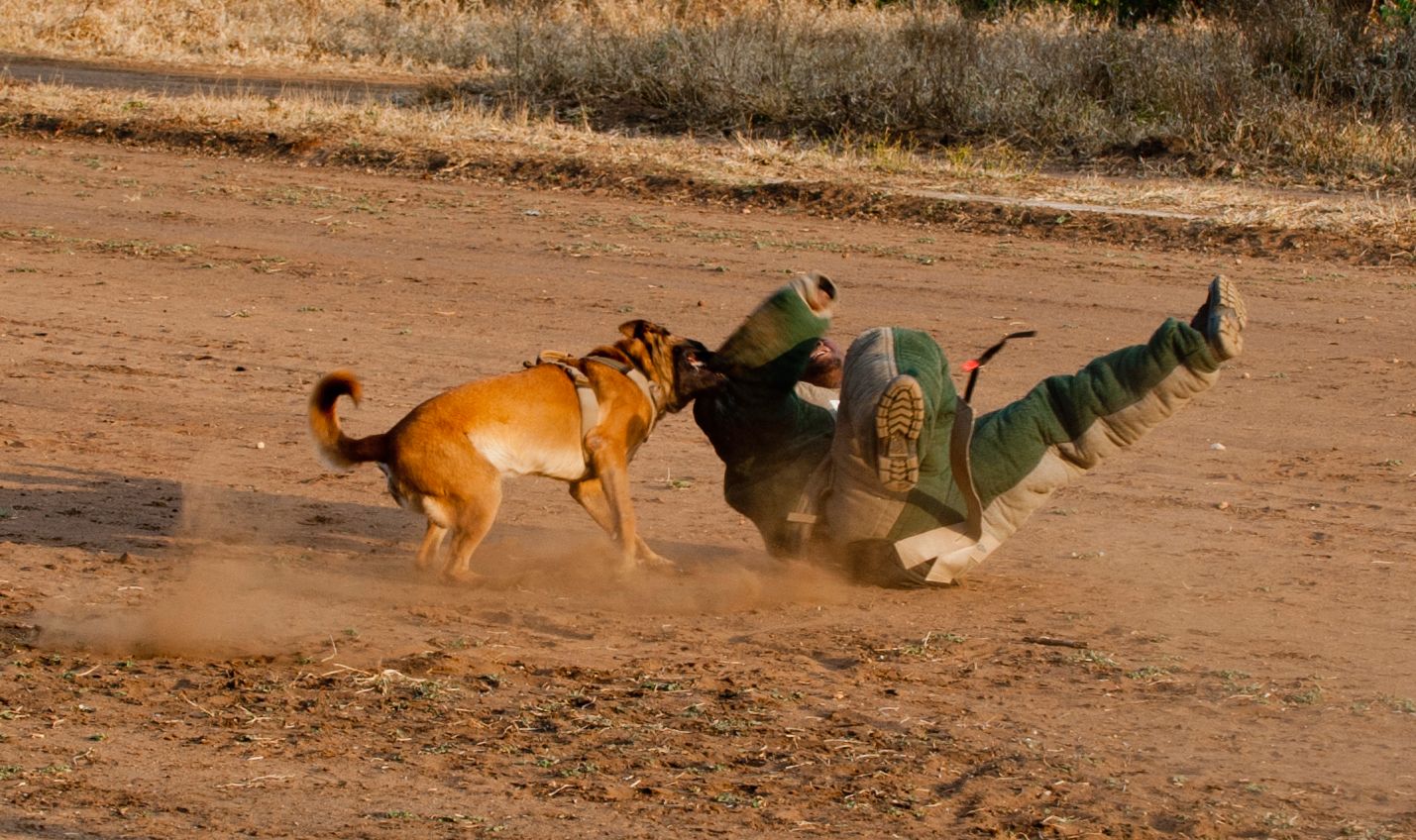
Gile the tracker malinois takes down a ‘poacher’ at Majete. (Photo: Don Pinnock)
Dreaming big
While Majete was the starting point for AP, in 20 years the NGO has grown, employing 1,100 highly trained rangers in Angola, Benin, Central African Republic, Chad, the Democratic Republic of Congo, Malawi, Mozambique, the Republic of the Congo, Rwanda, South Sudan, Zambia and Zimbabwe. AP is now widely acknowledged as the gold standard for park management.
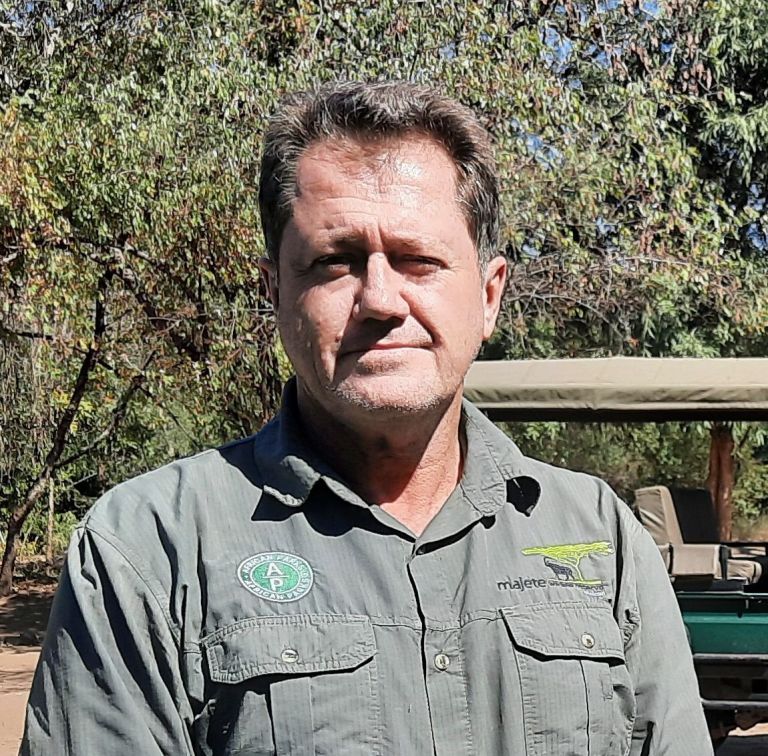
Park manager John Adendorff. (Photo: Don Pinnock)
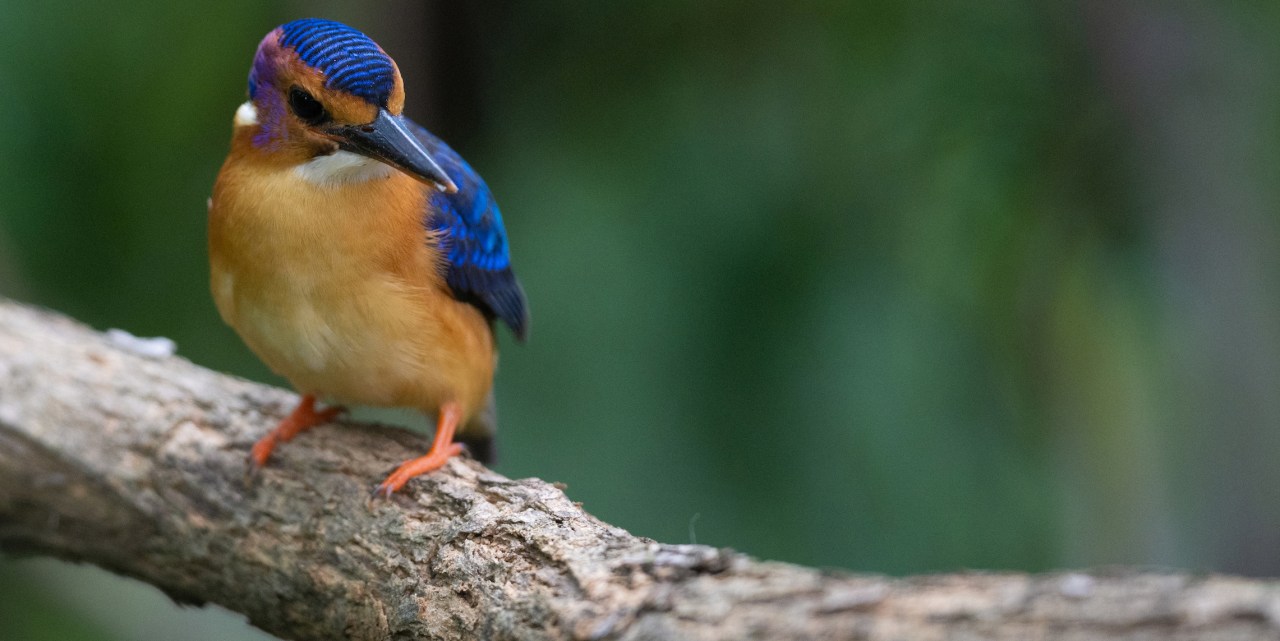
A kingfisher patrolling the Shire River at Majete. (Photo: Gael Vande weghe)
The NGO was formed in 2000 by Peter Fearnhead (the current CEO) Michael Eustace, Paul Fentener van Vlissingen, Anthony Hall-Martin and Mavuso Msimang (former CEO of SANParks) in response to the dramatic decline of protected areas across Africa from poor management and lack of funding. Prince Harry is the president.
In 2020, AP did an analysis of protected areas on the continent using its on-ground knowledge of the continent and the World Database of Protected Areas. What it found rang alarm bells.
While more than 8,000 protected areas were identified, most were too small to provide long-term resilience. Most of the larger areas were found to be suffering from decades of poor management and lack of resources. Many were “paper parks”– parks in name only, but with habitat and biodiversity lost.
Read more in Daily Maverick: With nature and biodiversity under threat everywhere, bold conservation funding ideas are needed
Focussing on what could be saved, AP identified 161 “anchor areas” (see map) with the greatest chance of being rehabilitated, and which contained globally significant biodiversity. Of these, it found only 69 managed in a way to ensure survival into the future.
The remaining 92 are experiencing uncontrolled poaching, habitat encroachment and degradation with little or no resources for their protection. Without resources and management, they are unlikely to survive.
In 2019, the Global Deal for Nature highlighted the need for at least 30% of terrestrial and marine areas to be protected if the planet’s biodiversity is to be secured, and the catastrophic consequences of a changing climate prevented.
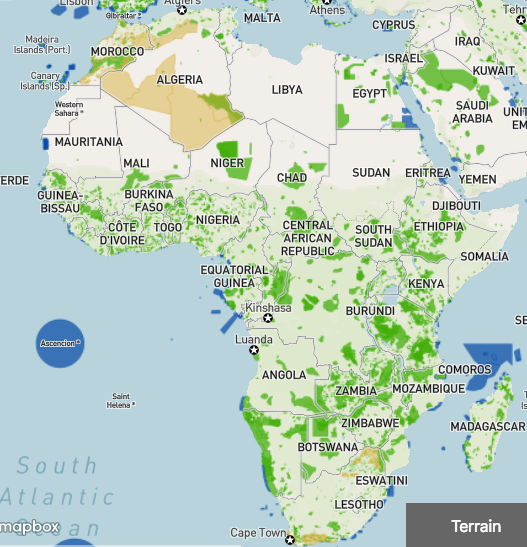
Africa protected areas. (Source: Mapbox)
Casting Our Vision – updated.
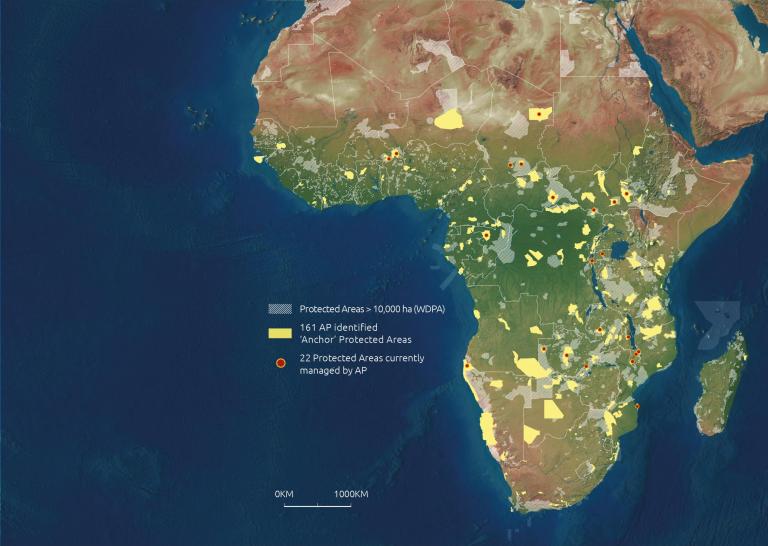
Ambitious roadmap for Africa
Using that as a goal for Africa, AP created an ambitious “roadmap” to secure the anchor areas and directly manage 30 protected areas by 2030. It has also created a mentorship programme to support other management programmes and NGOs to replicate AP successes in a further 10 areas. It’s a dream, but a realisable one, says Adendorff.
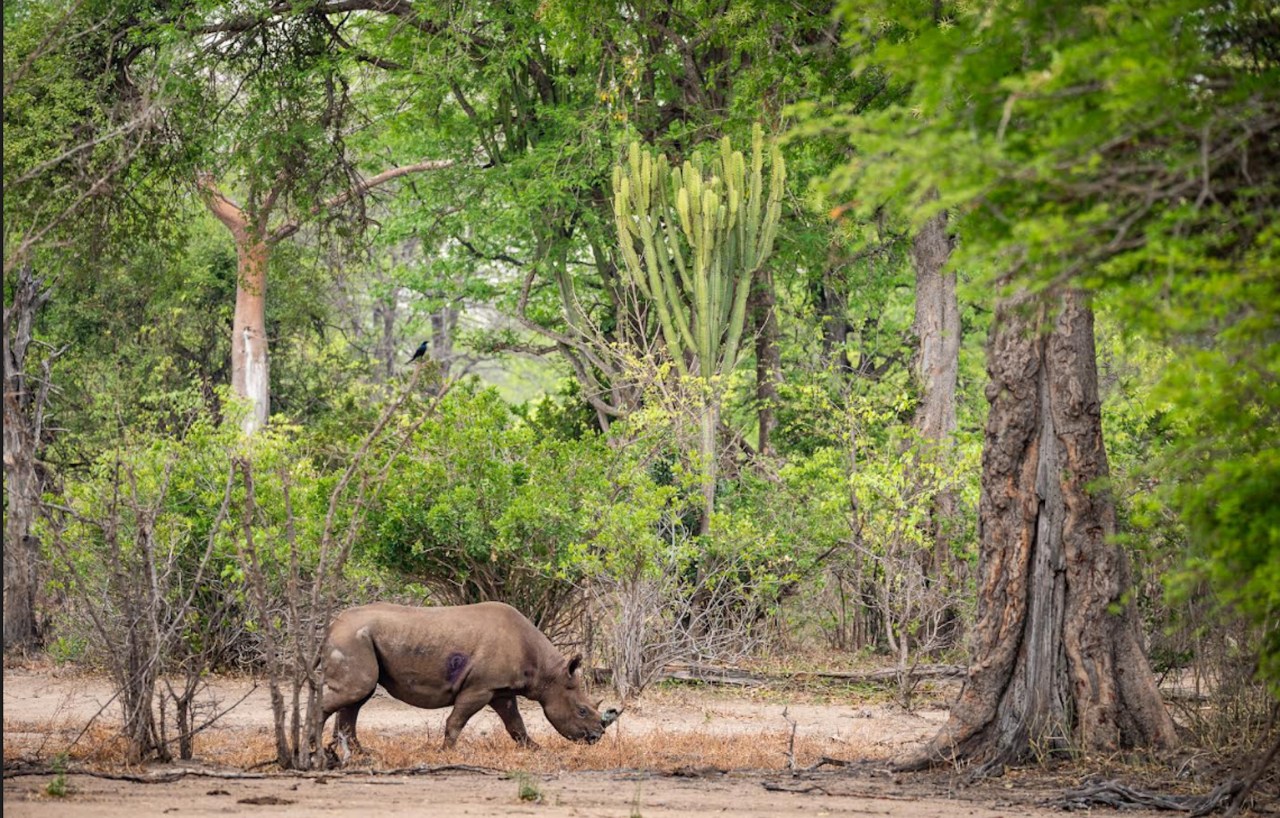
Guards protect Majete’s black rhino by tracking them every day. (Photo: Kyle de Nobrega)
“We have to buy time to change mindsets, change the landscape and empower locals. We at AP are an intermediary on the road to Africa caring for its own biodiversity and developing the skills to do that. Majete is spectacularly successful, but remember it’s taken 20 years by committed and passionate people. We’re in and part of a community who see benefit from bordering a wildlife area.
“Wildlife and the ecology of Africa is resilient, it will come back,” he said, as we watched a baboon outside his office inspecting the contents of his bakkie for a possible snack. “But we need to put certain key initiatives in place to make it work.
“We can’t rewild the traditional Western way of just stepping back. If we don’t manage intensively, if we don’t have community buy-in, it’s bound to fail. And we cannot fail Africa’s precious wild creatures and places.” DM

After their extirpation over 20 years ago lions are back in Majete. Photo: Marcus Westberg
By Don Pinnock | 17 Aug 2023
To conserve Earth’s biodiversity, the Global Deal for Nature calculated it would be necessary to protect 30% of the land and seas. Is that possible in Africa? A savvy conservation NGO has drawn up an African game plan that began with a single reserve.
___________________________________________________________________________________________________________________________
The message from Majete Wildlife Reserve in southern Malawi is that ecosystems in Africa can be rewilded, but only with intense human intervention.
Twenty years ago, the reserve was degraded land. Its animals had been poached to a few jittery kudu, waterbuck and warthogs, its ancient woodlands rendered to charcoal.
Today it’s been fully rewilded, with elephant, black rhino, lion, leopard, buffalo, wild dogs and many species of antelope. It is home to more than 300 species of birds and their dawn chorus is almost deafening.

Since their reintroduction, Majete’s buffalo herds have flourished. (Photo: John Dickens)
Giant trees line the streams and the Shire River, which flows along its boundary. A waterhole just beyond the lodge veranda presents extraordinary sightings of animals no longer wary of humans.
But the process necessary to arrive here required a rethink of the notion of rewilding, which traditionally focuses on “replacing human interventions with natural processes… to create resilient, self-regulating and self-sustaining ecosystems”.
On a continent with the world’s fastest-growing population, stepping back to allow nature to restore itself is simply not an option. That’s what Majete taught African Parks (AP), which manages the reserve. To rewild in Africa you need intense management on both sides of the fence.
Looking after what is outside the fence
In the past, the model for park management had always been to look after what’s inside the fence. The AP approach is to also look after who’s outside it. It’s become a model for what rewilding requires to conserve wildlife on the continent.
“I know a lot of people are scathing about fences,” says Majete Park Manager John Adendorff, but if you have human-animal conflict, you have massive problems. Your reserve is dead in the water.
“We had to draw a line in the sand and say, this is park, that is community land, and we put up a fence. Then we worked on either side of it to make sure the benefits flowed in both directions.”

Bee Harvesting at Mejete has been a lifeline for many people in villages surrounding the park (Photo: Heunis Naude)
Community Extension Manager Dixie Makwale took me down a bumpy track outside the park fence to show what that meant. We stopped at a centre built by AP that contained a clinic, creche, community grain store, maize mill, community bank and honey processing workshop. There’s electricity and free WiFi access.
“There was nothing here,” a woman in a brightly coloured kanga told me, indicating the buildings. “Now I’m a beekeeper. Honey paid for my house with a good roof and kept my children in school. My husband is also a beekeeper, but I have more hives than him. And we have a clinic.”
Dixie explained: “There are six of these centres – we call them epicentres – around the park. They’re in the six traditional authorities surrounding Majete. It’s incredibly important to respect these authorities. They’ve been there for thousands of years.
“They all come together as the Majete Wildlife Reserve Association to discuss the way forward and how to improve things. There’s a sense of ownership, they’re our conservation ambassadors. It’s about building real and emotional ownership.
“Also, along the Shire River there are fish farms and a central nursery provided up to 90,000 trees a year for the community to plant.”
Adendorff is understanding about why the park was degraded before AP took over. “Malawi is the third poorest country in Africa,” he said. “We can’t blame people for cutting down trees to sell as charcoal, it’s one of their main sources of income. But we can help them replant. We have to create sustainable enterprises.
“We also have to get kids to understand the value of wildlife. It’s no longer part of their cultural landscape. So we bring neighbouring youngsters into the park, house them in tents and tell stories around the fire at night. And we provide educational scholarships.”

Gile the tracker malinois and handler at Majete. (Photo: Don Pinnock)
Dogs and more
Gaining community support for the park is half the battle, managing it is the other half. In that, AP has plenty of experience, administering 22 parks in 12 countries across Africa. Majete was its first, and its training ground.
The reserve has tracker dogs and 44 highly trained and armed rangers who monitor rhinos every day, both on foot and electronically.
In a demonstration of the dogs’ ability, a suitably padded volunteer was tracked by Gile and Milo, a Belgian malinois and a Dutch shepherd. Gile hit the “poacher” so hard when it found him that he was rolled and held down.
Dog trainer Bright Maondo laughed when I asked if he’d had to take down poachers like that. “We never have to,” he said. “We do that demonstration in areas surrounding the reserve and almost nobody has jumped the fence.”
I wouldn’t either, after seeing what a trained dog can do.

Traps confiscated in Majete. (Photo: Don Pinnock)
Database tracking
Each day, beginning before sunrise, rangers are out tracking the park’s black rhinos. They report their location, photograph them and check their condition. All this goes into a database which, combined with satellite collars on a range of animals, makes it possible for Majete’s wildlife monitoring team to survey the reserve in real time.
Ongoing animal activity is projected on a screen, giving a detailed birds-eye view of who and where animals are and what they’re up to. Majete may be rewilded, but it’s very carefully watched.
“Any closed system with a growing population needs to be managed,” explained Adendorff. “Almost all mammals here were brought in. Protected, populations grow. We have to manage that. Law enforcement is essential, as is never becoming complacent.
“When I worked in conservation in South Africa, we thought we were the best and we protected everything. Now rhino destruction there is huge and they’re not able to get on top of it. That taught us here at Majete to be pre-emptive rather than reactive. The surrounding communities are part of that. If a syndicate tries to infiltrate them, we’ll know immediately. We haven’t had a rhino poached in 20 years.”

Gile the tracker malinois takes down a ‘poacher’ at Majete. (Photo: Don Pinnock)
Dreaming big
While Majete was the starting point for AP, in 20 years the NGO has grown, employing 1,100 highly trained rangers in Angola, Benin, Central African Republic, Chad, the Democratic Republic of Congo, Malawi, Mozambique, the Republic of the Congo, Rwanda, South Sudan, Zambia and Zimbabwe. AP is now widely acknowledged as the gold standard for park management.

Park manager John Adendorff. (Photo: Don Pinnock)

A kingfisher patrolling the Shire River at Majete. (Photo: Gael Vande weghe)
The NGO was formed in 2000 by Peter Fearnhead (the current CEO) Michael Eustace, Paul Fentener van Vlissingen, Anthony Hall-Martin and Mavuso Msimang (former CEO of SANParks) in response to the dramatic decline of protected areas across Africa from poor management and lack of funding. Prince Harry is the president.
In 2020, AP did an analysis of protected areas on the continent using its on-ground knowledge of the continent and the World Database of Protected Areas. What it found rang alarm bells.
While more than 8,000 protected areas were identified, most were too small to provide long-term resilience. Most of the larger areas were found to be suffering from decades of poor management and lack of resources. Many were “paper parks”– parks in name only, but with habitat and biodiversity lost.
Read more in Daily Maverick: With nature and biodiversity under threat everywhere, bold conservation funding ideas are needed
Focussing on what could be saved, AP identified 161 “anchor areas” (see map) with the greatest chance of being rehabilitated, and which contained globally significant biodiversity. Of these, it found only 69 managed in a way to ensure survival into the future.
The remaining 92 are experiencing uncontrolled poaching, habitat encroachment and degradation with little or no resources for their protection. Without resources and management, they are unlikely to survive.
In 2019, the Global Deal for Nature highlighted the need for at least 30% of terrestrial and marine areas to be protected if the planet’s biodiversity is to be secured, and the catastrophic consequences of a changing climate prevented.

Africa protected areas. (Source: Mapbox)
Casting Our Vision – updated.

Ambitious roadmap for Africa
Using that as a goal for Africa, AP created an ambitious “roadmap” to secure the anchor areas and directly manage 30 protected areas by 2030. It has also created a mentorship programme to support other management programmes and NGOs to replicate AP successes in a further 10 areas. It’s a dream, but a realisable one, says Adendorff.

Guards protect Majete’s black rhino by tracking them every day. (Photo: Kyle de Nobrega)
“We have to buy time to change mindsets, change the landscape and empower locals. We at AP are an intermediary on the road to Africa caring for its own biodiversity and developing the skills to do that. Majete is spectacularly successful, but remember it’s taken 20 years by committed and passionate people. We’re in and part of a community who see benefit from bordering a wildlife area.
“Wildlife and the ecology of Africa is resilient, it will come back,” he said, as we watched a baboon outside his office inspecting the contents of his bakkie for a possible snack. “But we need to put certain key initiatives in place to make it work.
“We can’t rewild the traditional Western way of just stepping back. If we don’t manage intensively, if we don’t have community buy-in, it’s bound to fail. And we cannot fail Africa’s precious wild creatures and places.” DM
"Education is the most powerful weapon which you can use to change the world." Nelson Mandela
The desire for equality must never exceed the demands of knowledge
The desire for equality must never exceed the demands of knowledge
- Lisbeth
- Site Admin
- Posts: 67563
- Joined: Sat May 19, 2012 12:31 pm
- Country: Switzerland
- Location: Lugano
- Contact:
Re: Biodiversity
The Government should get "African Parks" to manage all South African wildlife parks 
"Education is the most powerful weapon which you can use to change the world." Nelson Mandela
The desire for equality must never exceed the demands of knowledge
The desire for equality must never exceed the demands of knowledge
- Lisbeth
- Site Admin
- Posts: 67563
- Joined: Sat May 19, 2012 12:31 pm
- Country: Switzerland
- Location: Lugano
- Contact:
Re: Biodiversity
BIODIVERSITY STEWARDSHIP
Greater Anysberg Conservation Initiative sees new habitat and environment protections come into play
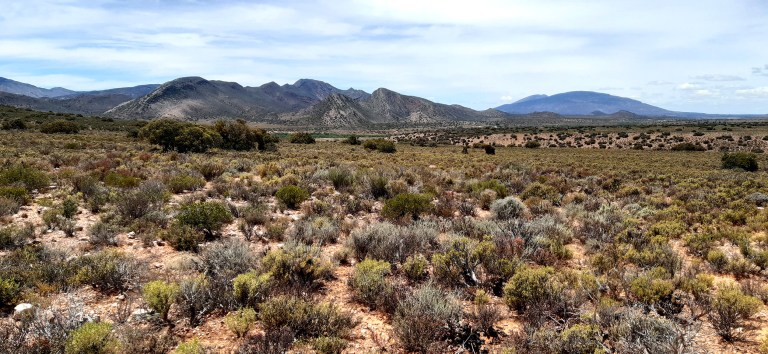
The landscape in the Greater Anysberg area is largely untransformed by agricultural cultivation and development. Despite the historical loss of biodiversity, there is still a tremendous amount of biodiversity in this landscape. (Photo: Endangered Wildlife Trust)
By Kristin Engel | 09 Oct 2023
In the arid region of the Succulent Karoo in the Western Cape, what was once six private livestock farms are now in the process of transitioning into a nature reserve with the aim of protecting a number of rare and threatened endemic plant and animal species.
__________________________________________________________________________________________________________________
Spanning 16,000 hectares in the Anysberg region near Touwsriver, the six farms were initially bought for livestock farming but changing climate conditions, habitat loss, and degradation have made these areas unsuitable for this purpose with landowners unable to make a profit.
Now these six private farms — Lettas Kraal, Machaseh, Kruisrivier, Silflay, Bloutoring, and Doringkloof Karoo Plaas — form part of the provincial biodiversity stewardship programme, the Greater Anysberg Conservation Initiative which is a collaboration between the landowners, CapeNature and the Endangered Wildlife Trust (EWT).
Through this collaboration, they hope to promote a sustainable landscape in the Anysberg area using new approaches to expand the conservation areas in the Karoo and to further protect endangered and threatened species and habitats surrounding the Anysberg Nature Reserve.
News of this initiative and the intention to declare more nature reserves came to the fore after the Department of Environmental Affairs and Development Planning (DEA and DP) in the Western Cape published a notice to declare the Silflay Renosterveld Nature Reserve in Swellendam at the end of August.
Silflay was only one of six properties in the process of being declared a nature reserve as part of the Greater Anysberg Conservation Initiative, Daily Maverick learnt after making inquiries about the new reserve.
Besides being nature reserves in their own right, the farms will also serve as a buffer along the western and southern front of the Anysberg Nature Reserve — a provincial nature reserve of about 80,000 hectares in size. Anysberg Nature Reserve is also a world heritage site.
Silflay’s declaration comes after a long process and a biodiversity assessment of the site by Cape Nature which found that the intended area contains a number of biodiversity attributes that make it eligible for declaration as a reserve.
Speaking to the Daily Maverick, Cape Nature spokesperson Petro van Rhyn said that one of these attributes includes habitat for the critically endangered Riverine Rabbit, which represents an expansion of the protection levels afforded this species. The declaration of these properties will considerably increase the area under formal protection in which riverine rabbits are known to occur.
Riverine rabbit were recorded in Ansberg in 2013, and on Sanbona back in 2003. They were not known to occur in any of the formally protected areas prior to the Anysberg discovery. Anysberg was therefore the first formally protected area in South Africa on record to have them.
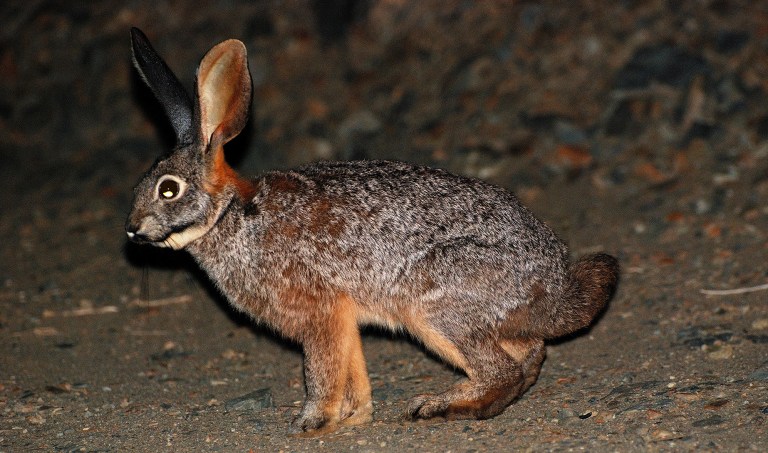
Through the Greater Anysberg Conservation Initiative, they hope to further protect endangered species and habitats in these areas, such as the critically endangered riverine rabbit, pictured above. (Photo: Keir Lynch)
In the case of Sanbona and the other properties, these are now being declared as nature reserves to increase formal protection of the areas in which riverine rabbits are known to occur.
“This is a significant achievement for riverine rabbit conservation. Further attributes are the provision of connectivity and landscape-scale ecosystem protection around the Anysberg Nature Reserve. This area is also now essentially a safe space for several species of conservation interest, such as Cape Leopard, Brown Hyena and Blue Crane. The property will be declared for the long-term protection of a range of these biodiversity attributes,” van Rhyn said.
The biodiversity site assessment is the very first step towards evaluating the biodiversity value of a site and has or will be done for each of the 6 private sites identified. The property is assessed, by CapeNature or whichever NGO may be leading the stewardship intervention (in the case of the above properties, the EWT was leading the process on the ground).
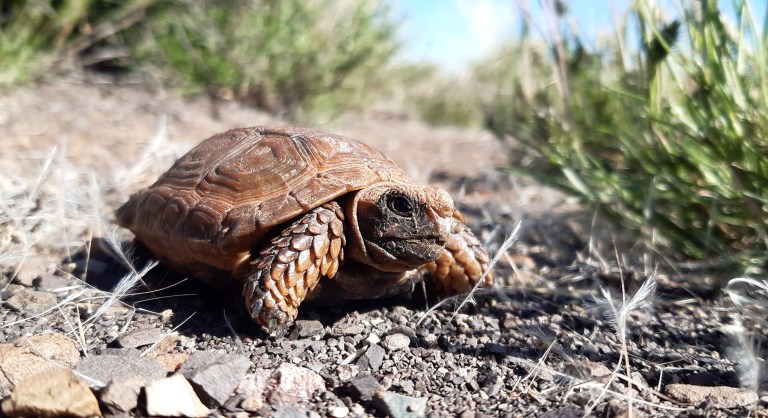
In future, these properties will be surveyed for species of conservation concern such as the endangered Karoo dwarf tortoise, pictured above which is known to occur in the Anysberg area. This is to ultimately assess how they are doing in these areas. (Photo: Endangered Wildlife Trust)
The information is then presented to CapeNature’s Protected Area Expansion Review Committee, (each province in the country follows a similar review process) to check if it is aligned with the Western Cape Protected Area Expansion Strategy. Based on the decisions made by the committee, all six properties were approved for declaration as nature reserves.
In an interview with Daily Maverick, Cobus Theron, programme manager for the Drylands Conservation Programme at the Endangered Wildlife Trust (EWT) — within which the Greater Anysberg Conservation Initiative falls — explained that biodiversity stewardship was a mechanism which enabled private landowners to commit their land towards conservation.
Once these sites are declared, they will have the same kind of status as any other Provincial Nature Reserve in South Africa, although the ownership will remain in private hands and depending on the owner, access to the public may be limited depending on what the land use and management priorities are for the property.
The properties will therefore be managed as private nature reserves going forward.
What is the Greater Conservation Anysberg Initiative?
The vision for this initiative was born 30 years ago when Johan Roodt bought Lettas Kraal, west of the Anysberg. In an interview with the Daily Maverick, Roodt said he had a vision for implementing conservation in the area after recognising its sensitive biodiversity was under threat by decades of overgrazing, poaching, sheep farming, and agricultural exploitation.
Over the years, Roodt corralled the other owners to undertake this vision and join the project. Together with the EWT and CapeNature, that vision is now being orchestrated.
Theron said, “We are doing this because these properties are important from a biodiversity perspective, and also part of our mission to secure protected areas for riverine rabbits in the southern population. There are three known regional riverine rabbit populations. The Anysberg region is home to the Southern population, and we want to protect land for the rabbits on these farms.”
The EWT and CapeNature have confirmed riverine rabbit presence on all the properties concerned.
Theron explained that the Greater Conservation Anysberg Initiative had three aims:
Bonnie Schumann, the EWT’s Nama Karoo coordinator for EWT’s Drylands Conservation Programme, said they were ultimately looking at nurturing an alternative green economy in this area to bring life back into this landscape, since the agricultural economy on its own could no longer function in that landscape.
This project also forms part of the Western Cape Protected Area Expansion Strategy for 2021 to 2025, aligned to the South African National Protected Area Expansion Strategy, the National Environmental Management: Protected Areas Act, and the CapeNature Strategic Plan 2021-2025.
“Because of their high conservation value, including the presence of several species of conservation concern, the properties will contribute to the Protected Area Expansion Strategy targets,” said Schumann.
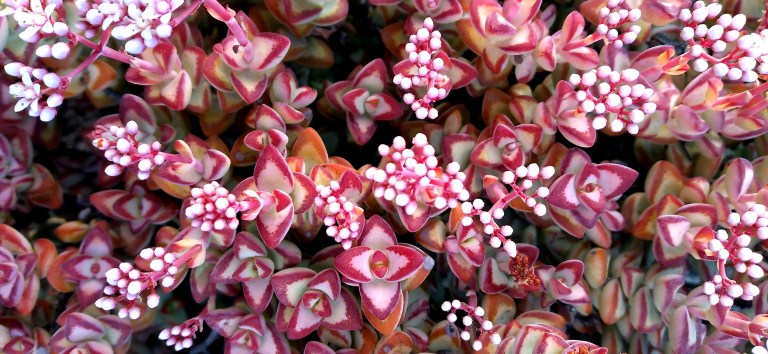
The Sosatie bos is one of the striking species found in the Succulent Karoo, the genus is the Crassula species. (Photo: Endangered Wildlife Trust)
These areas fall within those critical biodiversity areas that have been highlighted at a National and Provincial level.
Increasing protected areas at a landscape level is also important for resilience against climate change, by promoting ecosystem functioning and species survival across broad swathes of the landscape.
Van Rhyn added that this year marked 20 years of biodiversity stewardship in the province, across 73 privately owned stewardship sites totalling more than 200,000 hectares (20% of the total protected area network in the province) which have been added to the Western Cape protected area network over this period.
What the private landowners have to say about transitioning to Nature Reserves
In an interview with Daily Maverick, landowner Hilgard Bell said he took over the Bloutoring Farm in 1995 which spanned just under 5,000 hectares and was initially used for farming lucerne and sheep, but the conditions had not been conducive for livestock farming for decades.
Bell said they have seen ownership of other farms in the area constantly changing over the years with people unable to make a living.
“When we got involved we realised the veld couldn’t take the sheep but we continued with lucerne, but this became uneconomical because of the rise in electricity cost — with lucerne you have to pump the water to irrigate lucerne. We tried other projects there, trying to grow herbs for essential oils and the fragrance industry and eventually when we stopped that, we just let the veld rest,” Bell said
Bell said they make no income from the farm as it has been resting for over 25 years when they started with their own conservation activities and had a consultant come on to advise on which species there were to conserve.
“We are now about two years into the project (Greater Anysberg Conservation Initiative) and our farm has still not been declared (a nature reserve) yet, but we have concluded all the agreements and hopefully it will go through in the next few months,” he said.
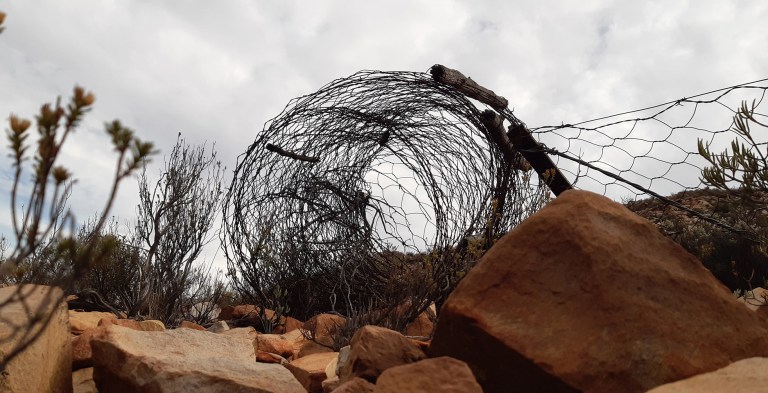
One of the internal fences being rolled up and removed at Lettas Kraal Farm in the Succulent Karoo. Taking down internal livestock camp fencing on properties is part of the Greater Anysberg Conservation Initiative in the Succulent Karoo to allow for the free movement of wildlife. (Photo: Endangered Wildlife Trust)
After this, like other landowners, Bell hopes they will be able to venture into eco-tourism and not only be able to make a living off the land again but also protect the rare and endangered species found in the region.
“We have new animals moving in and then moving out. We’ve had a recent influx of Eland for about four years and then they disappeared. They moved because with more and more people putting up game fences, their movement is restricted,” said Bell.
Ultimately, the collaborators of the Greater Anysberg Conservation Initiative hope this project will result in fences coming down to allow the free movement of game in response to environmental conditions across the landscape.
Nature conservation specialists Keir and Alouise Lynch who run their own ecological consultancy, BioNerds, are currently working with the EWT to develop a cluster management plan for four of the properties in the Anysberg area.
Through BioNerds, they look at uncovering new populations of very threatened species and then work towards the negotiation of those parcels of habitat into the Protected Area Network. Critical to this process is the development of management plans together with the landowners to ensure that the environment is managed to promote ecosystem resilience. DM
Greater Anysberg Conservation Initiative sees new habitat and environment protections come into play

The landscape in the Greater Anysberg area is largely untransformed by agricultural cultivation and development. Despite the historical loss of biodiversity, there is still a tremendous amount of biodiversity in this landscape. (Photo: Endangered Wildlife Trust)
By Kristin Engel | 09 Oct 2023
In the arid region of the Succulent Karoo in the Western Cape, what was once six private livestock farms are now in the process of transitioning into a nature reserve with the aim of protecting a number of rare and threatened endemic plant and animal species.
__________________________________________________________________________________________________________________
Spanning 16,000 hectares in the Anysberg region near Touwsriver, the six farms were initially bought for livestock farming but changing climate conditions, habitat loss, and degradation have made these areas unsuitable for this purpose with landowners unable to make a profit.
Now these six private farms — Lettas Kraal, Machaseh, Kruisrivier, Silflay, Bloutoring, and Doringkloof Karoo Plaas — form part of the provincial biodiversity stewardship programme, the Greater Anysberg Conservation Initiative which is a collaboration between the landowners, CapeNature and the Endangered Wildlife Trust (EWT).
Through this collaboration, they hope to promote a sustainable landscape in the Anysberg area using new approaches to expand the conservation areas in the Karoo and to further protect endangered and threatened species and habitats surrounding the Anysberg Nature Reserve.
News of this initiative and the intention to declare more nature reserves came to the fore after the Department of Environmental Affairs and Development Planning (DEA and DP) in the Western Cape published a notice to declare the Silflay Renosterveld Nature Reserve in Swellendam at the end of August.
Silflay was only one of six properties in the process of being declared a nature reserve as part of the Greater Anysberg Conservation Initiative, Daily Maverick learnt after making inquiries about the new reserve.
Besides being nature reserves in their own right, the farms will also serve as a buffer along the western and southern front of the Anysberg Nature Reserve — a provincial nature reserve of about 80,000 hectares in size. Anysberg Nature Reserve is also a world heritage site.
Silflay’s declaration comes after a long process and a biodiversity assessment of the site by Cape Nature which found that the intended area contains a number of biodiversity attributes that make it eligible for declaration as a reserve.
Speaking to the Daily Maverick, Cape Nature spokesperson Petro van Rhyn said that one of these attributes includes habitat for the critically endangered Riverine Rabbit, which represents an expansion of the protection levels afforded this species. The declaration of these properties will considerably increase the area under formal protection in which riverine rabbits are known to occur.
Riverine rabbit were recorded in Ansberg in 2013, and on Sanbona back in 2003. They were not known to occur in any of the formally protected areas prior to the Anysberg discovery. Anysberg was therefore the first formally protected area in South Africa on record to have them.

Through the Greater Anysberg Conservation Initiative, they hope to further protect endangered species and habitats in these areas, such as the critically endangered riverine rabbit, pictured above. (Photo: Keir Lynch)
In the case of Sanbona and the other properties, these are now being declared as nature reserves to increase formal protection of the areas in which riverine rabbits are known to occur.
“This is a significant achievement for riverine rabbit conservation. Further attributes are the provision of connectivity and landscape-scale ecosystem protection around the Anysberg Nature Reserve. This area is also now essentially a safe space for several species of conservation interest, such as Cape Leopard, Brown Hyena and Blue Crane. The property will be declared for the long-term protection of a range of these biodiversity attributes,” van Rhyn said.
The biodiversity site assessment is the very first step towards evaluating the biodiversity value of a site and has or will be done for each of the 6 private sites identified. The property is assessed, by CapeNature or whichever NGO may be leading the stewardship intervention (in the case of the above properties, the EWT was leading the process on the ground).

In future, these properties will be surveyed for species of conservation concern such as the endangered Karoo dwarf tortoise, pictured above which is known to occur in the Anysberg area. This is to ultimately assess how they are doing in these areas. (Photo: Endangered Wildlife Trust)
The information is then presented to CapeNature’s Protected Area Expansion Review Committee, (each province in the country follows a similar review process) to check if it is aligned with the Western Cape Protected Area Expansion Strategy. Based on the decisions made by the committee, all six properties were approved for declaration as nature reserves.
In an interview with Daily Maverick, Cobus Theron, programme manager for the Drylands Conservation Programme at the Endangered Wildlife Trust (EWT) — within which the Greater Anysberg Conservation Initiative falls — explained that biodiversity stewardship was a mechanism which enabled private landowners to commit their land towards conservation.
Once these sites are declared, they will have the same kind of status as any other Provincial Nature Reserve in South Africa, although the ownership will remain in private hands and depending on the owner, access to the public may be limited depending on what the land use and management priorities are for the property.
The properties will therefore be managed as private nature reserves going forward.
What is the Greater Conservation Anysberg Initiative?
The vision for this initiative was born 30 years ago when Johan Roodt bought Lettas Kraal, west of the Anysberg. In an interview with the Daily Maverick, Roodt said he had a vision for implementing conservation in the area after recognising its sensitive biodiversity was under threat by decades of overgrazing, poaching, sheep farming, and agricultural exploitation.
Over the years, Roodt corralled the other owners to undertake this vision and join the project. Together with the EWT and CapeNature, that vision is now being orchestrated.
Theron said, “We are doing this because these properties are important from a biodiversity perspective, and also part of our mission to secure protected areas for riverine rabbits in the southern population. There are three known regional riverine rabbit populations. The Anysberg region is home to the Southern population, and we want to protect land for the rabbits on these farms.”
The EWT and CapeNature have confirmed riverine rabbit presence on all the properties concerned.
Theron explained that the Greater Conservation Anysberg Initiative had three aims:
- To protect additional land by creating a greater conservation area bordering the Anysberg Nature Reserve to conserve the unique biodiversity of the Succulent Karoo and Fynbos Biomes.
- To investigate and apply the use of advanced technology to survey for highly elusive species, and to analyze genetic data using environmental DNA (eDNA). This is done by analyzing small amounts of soil collected in the area, and “extracting” and DNA material that is present. “We can basically see what walked there and what lived there by analyzing the soil. We are using this project to push the limits of environmental DNA research and develop it further,” said Theron.
- Exploring options to transition the area from a failed historical agricultural economy to a nature-based tourism “green” economy. As such aspects such as skills development in the tourism industry, and promoting nature-based activities are being addressed.
Bonnie Schumann, the EWT’s Nama Karoo coordinator for EWT’s Drylands Conservation Programme, said they were ultimately looking at nurturing an alternative green economy in this area to bring life back into this landscape, since the agricultural economy on its own could no longer function in that landscape.
This project also forms part of the Western Cape Protected Area Expansion Strategy for 2021 to 2025, aligned to the South African National Protected Area Expansion Strategy, the National Environmental Management: Protected Areas Act, and the CapeNature Strategic Plan 2021-2025.
“Because of their high conservation value, including the presence of several species of conservation concern, the properties will contribute to the Protected Area Expansion Strategy targets,” said Schumann.

The Sosatie bos is one of the striking species found in the Succulent Karoo, the genus is the Crassula species. (Photo: Endangered Wildlife Trust)
These areas fall within those critical biodiversity areas that have been highlighted at a National and Provincial level.
Increasing protected areas at a landscape level is also important for resilience against climate change, by promoting ecosystem functioning and species survival across broad swathes of the landscape.
Van Rhyn added that this year marked 20 years of biodiversity stewardship in the province, across 73 privately owned stewardship sites totalling more than 200,000 hectares (20% of the total protected area network in the province) which have been added to the Western Cape protected area network over this period.
What the private landowners have to say about transitioning to Nature Reserves
In an interview with Daily Maverick, landowner Hilgard Bell said he took over the Bloutoring Farm in 1995 which spanned just under 5,000 hectares and was initially used for farming lucerne and sheep, but the conditions had not been conducive for livestock farming for decades.
Bell said they have seen ownership of other farms in the area constantly changing over the years with people unable to make a living.
“When we got involved we realised the veld couldn’t take the sheep but we continued with lucerne, but this became uneconomical because of the rise in electricity cost — with lucerne you have to pump the water to irrigate lucerne. We tried other projects there, trying to grow herbs for essential oils and the fragrance industry and eventually when we stopped that, we just let the veld rest,” Bell said
Bell said they make no income from the farm as it has been resting for over 25 years when they started with their own conservation activities and had a consultant come on to advise on which species there were to conserve.
“We are now about two years into the project (Greater Anysberg Conservation Initiative) and our farm has still not been declared (a nature reserve) yet, but we have concluded all the agreements and hopefully it will go through in the next few months,” he said.

One of the internal fences being rolled up and removed at Lettas Kraal Farm in the Succulent Karoo. Taking down internal livestock camp fencing on properties is part of the Greater Anysberg Conservation Initiative in the Succulent Karoo to allow for the free movement of wildlife. (Photo: Endangered Wildlife Trust)
After this, like other landowners, Bell hopes they will be able to venture into eco-tourism and not only be able to make a living off the land again but also protect the rare and endangered species found in the region.
“We have new animals moving in and then moving out. We’ve had a recent influx of Eland for about four years and then they disappeared. They moved because with more and more people putting up game fences, their movement is restricted,” said Bell.
Ultimately, the collaborators of the Greater Anysberg Conservation Initiative hope this project will result in fences coming down to allow the free movement of game in response to environmental conditions across the landscape.
Nature conservation specialists Keir and Alouise Lynch who run their own ecological consultancy, BioNerds, are currently working with the EWT to develop a cluster management plan for four of the properties in the Anysberg area.
Through BioNerds, they look at uncovering new populations of very threatened species and then work towards the negotiation of those parcels of habitat into the Protected Area Network. Critical to this process is the development of management plans together with the landowners to ensure that the environment is managed to promote ecosystem resilience. DM
"Education is the most powerful weapon which you can use to change the world." Nelson Mandela
The desire for equality must never exceed the demands of knowledge
The desire for equality must never exceed the demands of knowledge
- Lisbeth
- Site Admin
- Posts: 67563
- Joined: Sat May 19, 2012 12:31 pm
- Country: Switzerland
- Location: Lugano
- Contact:
Re: Biodiversity
"Education is the most powerful weapon which you can use to change the world." Nelson Mandela
The desire for equality must never exceed the demands of knowledge
The desire for equality must never exceed the demands of knowledge
- Lisbeth
- Site Admin
- Posts: 67563
- Joined: Sat May 19, 2012 12:31 pm
- Country: Switzerland
- Location: Lugano
- Contact:
Re: Biodiversity
Wildlife economies have power to extend Africa’s biodiversity conservation and help curb climate change
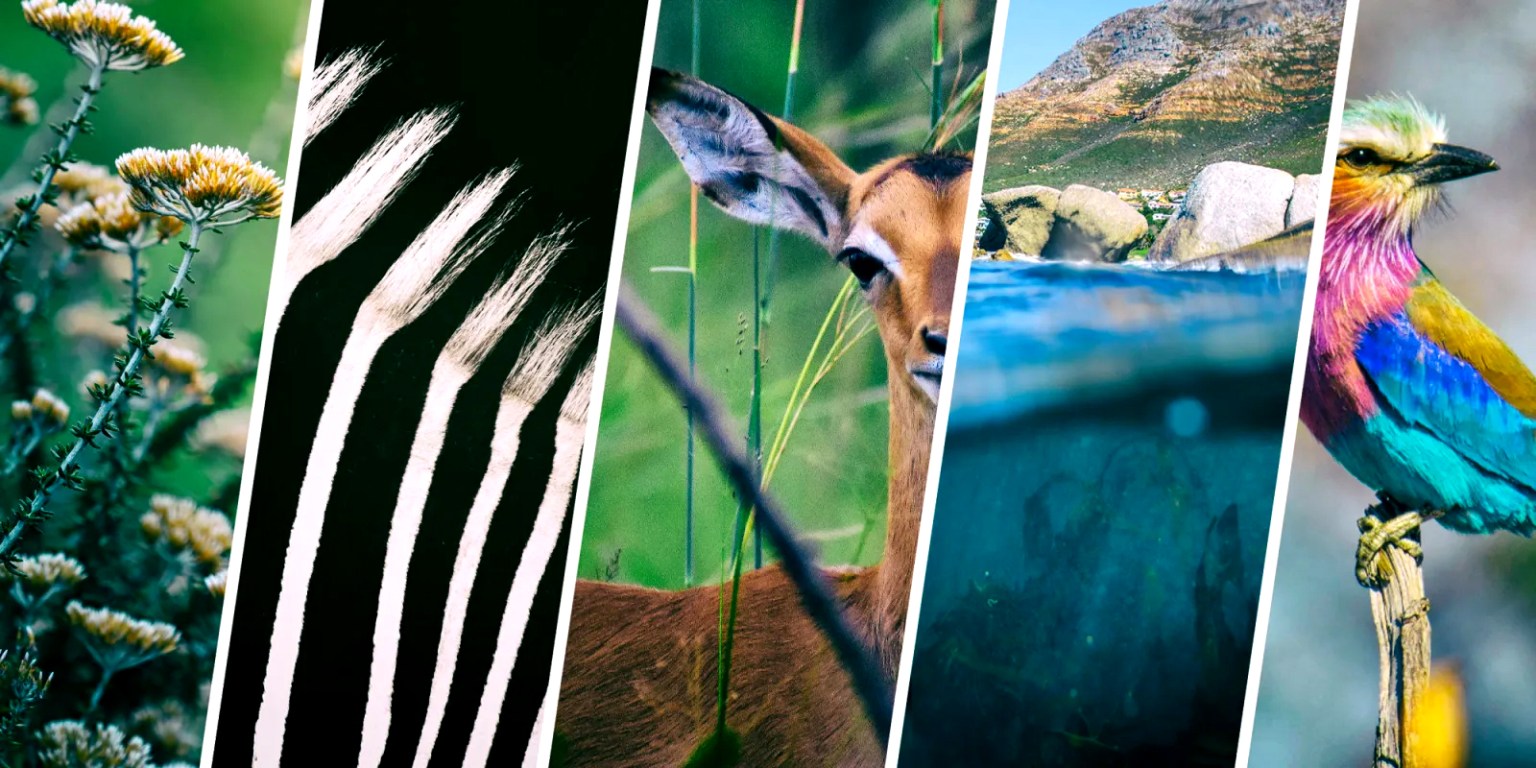
According to the authors, conventional protected areas are unlikely to conserve the land area necessary to curb the extinction of plants and animals, and secure the ecosystem services. (Photos: Unsplash / Nadine Venter | Janine Joles | EPA / Nic Bothma)
By Francis Vorhies, Hayley Clements and Wiseman Ndlovu | 04 Dec 2023
Sustainable use of wild meat value chains contributes to carbon sequestration and local climate regulation. Wildlife economies have more diverse revenue streams than conventional agriculture. Boosting wild meat consumption will help rewilding and restoring landscapes.
____________________________________________________________________________________________________________________________
Conventional protected areas are unlikely to conserve the land area necessary to curb the extinction of plants and animals, and secure the ecosystem services on which millions of people across Africa depend. Different nature-friendly wildlife enterprises are one way in which this footprint can be extended to achieve conservation outcomes and mitigate climate impact.
One of the objectives at COP28 will be how to implement the 30×30 target to tackle climate change, which represents the commitment of governments to conserve, protect, and restore at least 30% of the planet’s land and ocean by 2030.
The Africa chapter of the latest report of the Intergovernmental Panel on Climate Change highlights the significance of ecosystem services to African people and the risks presented by climate change. For example, based on a fossil-fuel development scenario, 1.2 billion African people are predicted to be negatively affected by water pollution due to reduced water quality regulation by ecosystems; 27 million by reduced coastal risk mitigation by ecosystems and 1.5 billion by lost crop production due to reduced wild pollinators. The number of people negatively affected by diminished ecosystem services reduces to 0.4 billion, 22 million and 0.7 billion respectively under a sustainable development scenario.
Conserving Africa’s biodiversity and the ecosystem services it provides should therefore be central to climate change responses, given the high dependence of people on these services.
Research shows that there will be reduced species representation in African protected areas due to climate-induced range shifts, with range shifts impeded by increasing land transformation and fencing. Research further predicts that conserving 30% of sub-Saharan Africa’s land area could reduce aggregate extinction risk of plants and vertebrates across the continent by up to 68.6%. Conventional protected areas are unlikely to meet this 30% goal, given resource constraints of African governments and the importance of access to land and its resources for sustainable livelihoods.
Wildlife economies
Africa needs to increase the extent of conserved ecosystems to mitigate biodiversity loss under climate change and needs complementary conservation strategies to mitigate the effects of climate change on biodiversity. Wildlife economies present one such strategy — increasing the extent of conserved ecosystems and their connectivity, while also contributing to livelihoods and food security through sustainable wildlife use (hunting, harvesting, meat) and tourism.
Ecosystem-Based Adaptation interventions comprise a third of all nationally determined contributions in Africa. Such interventions can promote both climate change mitigation and adaptation simultaneously.
Wildlife economies are one example of such an intervention, since they
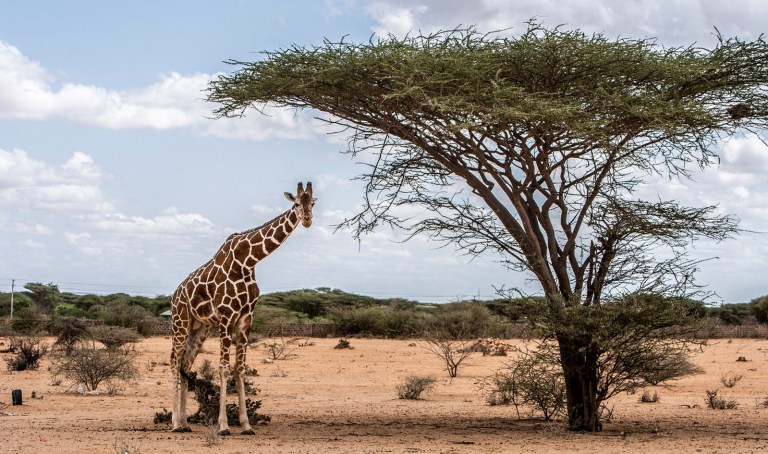
Giraffe populations have declined by 40% in the last 30 years, and there are now fewer than 70,000 mature individuals left in the wild. (Photo: Simon Marks / Bloomberg via Getty Images)
Policy changes in South Africa will accelerate the prospects of success for such interventions. A newly gazetted game meat strategy paper is set to transform and formalise the game meat industry, enabling big retail outlets to put more wildlife meat on shelves. At the moment only about 10% of game meat is formally marketed through retail outlets.
The strategy paper says it aims “to create a formalised game meat industry and achieve economies of scale necessary for commercial ventures based on game meat production, harvesting, distribution and marketing”.
Restoring landscapes
The AWEI at Stellenbosch University is promoting wildlife economies to restore/rewild and conserve African landscapes. This includes developing wild meat value chains, liberalising intra-African trade in wild meat and providing decision support tools for developing viable wildlife enterprises. Further, there are opportunities to align biodiversity conservation, climate responses, and livelihoods in developing Africa’s ‘blue economy’ including ocean-based climate change mitigation.
AWEI research supports the argument that commercial interests and scaling of wild meat consumption present a unique opportunity for rewilding and restoring landscapes. Thus, sustainable use of wild meat translates to the protection and expansion of wildlife habitats with triple effects on biodiversity (e.g., reintroduction of insects, vegetation, well-managed landscapes in care of animal habitats, etc.).
This supports the decision on sustainable wildlife management adopted at COP14, and supports using voluntary guidance for a sustainable wild meat sector. It also seeks to promote the sustainability of supply at the source, managing the demand along the entire value chain, and creating the enabling conditions for legal, sustainable management of terrestrial wild meat in tropical and subtropical habitats.
Developing a sustainable use of wild meat value chains across the continent is a game changer as it contributes to not only landscape restoration but also helps mitigate climate impact through carbon sequestration, local climate regulation and improved water management.
In this regard, AWEI’s approach to sustainable use as an area-based conservation measure offers a pathway to implementing landscape-based climate responses in support of both UN Framework Convention on Climate Change and Convention on Biological Diversity objectives.
This includes the recently launched Global Biodiversity Framework and, notably, its target to: “Minimise the impact of climate change and ocean acidification on biodiversity and increase its resilience through mitigation, adaptation, and disaster risk reduction actions, including through nature-based solutions and/or ecosystem-based approaches, while minimising negative and fostering positive impacts of climate action on biodiversity.”
In line with COP28’s core theme, of “investing in climate solutions by committing and investments in nature-positive projects, policies and practices” AWEI research opens doors for identifying investment options that support successful scaling of different nature friendly wildlife enterprises to achieve conservation outcomes and mitigate climate impact. DM
Dr Francis Vorhies is the Director and Co-Founder of AWEI.
Dr Hayley Clements is Senior Researcher at Stellenbosch University and University of Helsinki, and a Research Chair at AWEI.
Dr Wiseman Ndlovu is a postdoctoral research fellow at AWEI at Stellenbosch University.

According to the authors, conventional protected areas are unlikely to conserve the land area necessary to curb the extinction of plants and animals, and secure the ecosystem services. (Photos: Unsplash / Nadine Venter | Janine Joles | EPA / Nic Bothma)
By Francis Vorhies, Hayley Clements and Wiseman Ndlovu | 04 Dec 2023
Sustainable use of wild meat value chains contributes to carbon sequestration and local climate regulation. Wildlife economies have more diverse revenue streams than conventional agriculture. Boosting wild meat consumption will help rewilding and restoring landscapes.
____________________________________________________________________________________________________________________________
Conventional protected areas are unlikely to conserve the land area necessary to curb the extinction of plants and animals, and secure the ecosystem services on which millions of people across Africa depend. Different nature-friendly wildlife enterprises are one way in which this footprint can be extended to achieve conservation outcomes and mitigate climate impact.
One of the objectives at COP28 will be how to implement the 30×30 target to tackle climate change, which represents the commitment of governments to conserve, protect, and restore at least 30% of the planet’s land and ocean by 2030.
The Africa chapter of the latest report of the Intergovernmental Panel on Climate Change highlights the significance of ecosystem services to African people and the risks presented by climate change. For example, based on a fossil-fuel development scenario, 1.2 billion African people are predicted to be negatively affected by water pollution due to reduced water quality regulation by ecosystems; 27 million by reduced coastal risk mitigation by ecosystems and 1.5 billion by lost crop production due to reduced wild pollinators. The number of people negatively affected by diminished ecosystem services reduces to 0.4 billion, 22 million and 0.7 billion respectively under a sustainable development scenario.
Conserving Africa’s biodiversity and the ecosystem services it provides should therefore be central to climate change responses, given the high dependence of people on these services.
Research shows that there will be reduced species representation in African protected areas due to climate-induced range shifts, with range shifts impeded by increasing land transformation and fencing. Research further predicts that conserving 30% of sub-Saharan Africa’s land area could reduce aggregate extinction risk of plants and vertebrates across the continent by up to 68.6%. Conventional protected areas are unlikely to meet this 30% goal, given resource constraints of African governments and the importance of access to land and its resources for sustainable livelihoods.
Wildlife economies
Africa needs to increase the extent of conserved ecosystems to mitigate biodiversity loss under climate change and needs complementary conservation strategies to mitigate the effects of climate change on biodiversity. Wildlife economies present one such strategy — increasing the extent of conserved ecosystems and their connectivity, while also contributing to livelihoods and food security through sustainable wildlife use (hunting, harvesting, meat) and tourism.
Ecosystem-Based Adaptation interventions comprise a third of all nationally determined contributions in Africa. Such interventions can promote both climate change mitigation and adaptation simultaneously.
Wildlife economies are one example of such an intervention, since they
- have been shown to be more viable than livestock in low rainfall areas (which span much of Africa’s open ecosystems), particularly under climate change; and
- can increase soil carbon sequestration through rewilding.

Giraffe populations have declined by 40% in the last 30 years, and there are now fewer than 70,000 mature individuals left in the wild. (Photo: Simon Marks / Bloomberg via Getty Images)
Policy changes in South Africa will accelerate the prospects of success for such interventions. A newly gazetted game meat strategy paper is set to transform and formalise the game meat industry, enabling big retail outlets to put more wildlife meat on shelves. At the moment only about 10% of game meat is formally marketed through retail outlets.
The strategy paper says it aims “to create a formalised game meat industry and achieve economies of scale necessary for commercial ventures based on game meat production, harvesting, distribution and marketing”.
Restoring landscapes
The AWEI at Stellenbosch University is promoting wildlife economies to restore/rewild and conserve African landscapes. This includes developing wild meat value chains, liberalising intra-African trade in wild meat and providing decision support tools for developing viable wildlife enterprises. Further, there are opportunities to align biodiversity conservation, climate responses, and livelihoods in developing Africa’s ‘blue economy’ including ocean-based climate change mitigation.
AWEI research supports the argument that commercial interests and scaling of wild meat consumption present a unique opportunity for rewilding and restoring landscapes. Thus, sustainable use of wild meat translates to the protection and expansion of wildlife habitats with triple effects on biodiversity (e.g., reintroduction of insects, vegetation, well-managed landscapes in care of animal habitats, etc.).
This supports the decision on sustainable wildlife management adopted at COP14, and supports using voluntary guidance for a sustainable wild meat sector. It also seeks to promote the sustainability of supply at the source, managing the demand along the entire value chain, and creating the enabling conditions for legal, sustainable management of terrestrial wild meat in tropical and subtropical habitats.
Developing a sustainable use of wild meat value chains across the continent is a game changer as it contributes to not only landscape restoration but also helps mitigate climate impact through carbon sequestration, local climate regulation and improved water management.
In this regard, AWEI’s approach to sustainable use as an area-based conservation measure offers a pathway to implementing landscape-based climate responses in support of both UN Framework Convention on Climate Change and Convention on Biological Diversity objectives.
This includes the recently launched Global Biodiversity Framework and, notably, its target to: “Minimise the impact of climate change and ocean acidification on biodiversity and increase its resilience through mitigation, adaptation, and disaster risk reduction actions, including through nature-based solutions and/or ecosystem-based approaches, while minimising negative and fostering positive impacts of climate action on biodiversity.”
In line with COP28’s core theme, of “investing in climate solutions by committing and investments in nature-positive projects, policies and practices” AWEI research opens doors for identifying investment options that support successful scaling of different nature friendly wildlife enterprises to achieve conservation outcomes and mitigate climate impact. DM
Dr Francis Vorhies is the Director and Co-Founder of AWEI.
Dr Hayley Clements is Senior Researcher at Stellenbosch University and University of Helsinki, and a Research Chair at AWEI.
Dr Wiseman Ndlovu is a postdoctoral research fellow at AWEI at Stellenbosch University.
"Education is the most powerful weapon which you can use to change the world." Nelson Mandela
The desire for equality must never exceed the demands of knowledge
The desire for equality must never exceed the demands of knowledge
- Lisbeth
- Site Admin
- Posts: 67563
- Joined: Sat May 19, 2012 12:31 pm
- Country: Switzerland
- Location: Lugano
- Contact:
Re: Biodiversity
"Education is the most powerful weapon which you can use to change the world." Nelson Mandela
The desire for equality must never exceed the demands of knowledge
The desire for equality must never exceed the demands of knowledge
- Lisbeth
- Site Admin
- Posts: 67563
- Joined: Sat May 19, 2012 12:31 pm
- Country: Switzerland
- Location: Lugano
- Contact:
Re: Biodiversity
‘BIODIVERSITY BUSINESS’
Government trying to slam through plan that will result in massive exploitation of wildlife
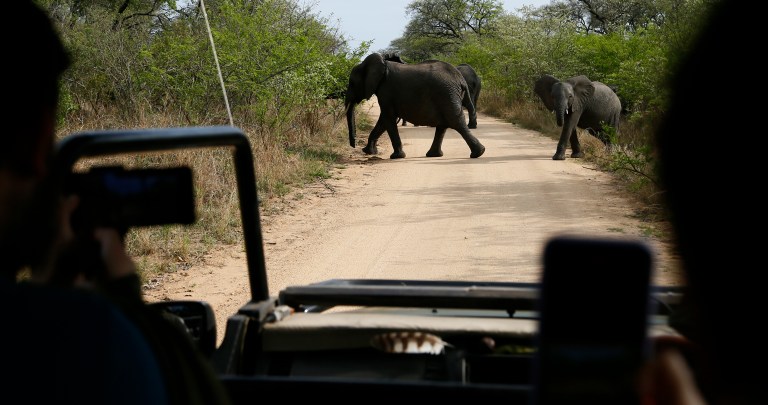
A herd of elephants at the Numbi Gate of the Kruger National Park in Mbombela, Mpumalanga. (Photo: Gallo Images / Daily Maverick / Felix Dlangamandla)
By Don Pinnock | 18 Mar 2024
By Friday, 22 March, the public is expected to have commented on a detailed plan by the Department of Forestry, Fisheries and the Environment to massively exploit and monetise South Africa’s wildlife. The public was given just 14 days to respond.
______________________________________________________________________________________________________________________________
The Department of Forestry, Fisheries and the Environment (DFFE) has released a 48-page plan to create integrated “mega landscapes” on land and sea encompassing extensive areas where hunting, bioprospecting and tourism would monetise wild animals and plants for “consumptive use”.
To do this, the government will attempt to mobilise state and private resources, starting with an indaba in Gauteng from 24 to 26 March. The Birchwood Hotel and OR Tambo Conference Centre have been hired for the event at a cost of R3,698,859.
The plan was released on 8 March and gives the public until 22 March to comment, a 14-day deadline that many see as a box-ticking exercise to claim that the public has been consulted before the plan goes on show at the indaba.
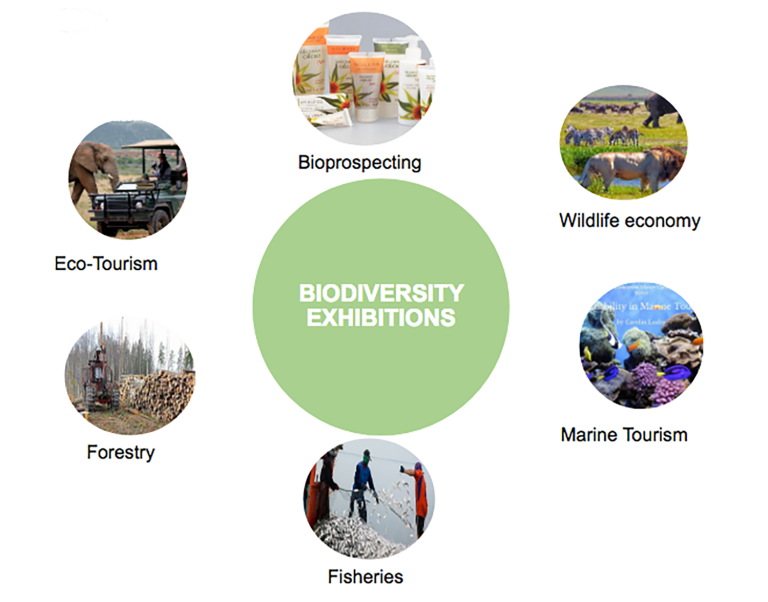
Schematic for a government plant for the creation of mega-landscapes. (Image: Supplied)
The proposal is to grow areas under conservation — called mega living conservation landscapes — from 20 million hectares to 34 million hectares by 2040, an area equal to seven Kruger National Parks. Five mega landscapes are suggested, with proposals including:
“Consumptive use” of wild animals within these landscapes is predicted by the plan to increase from R4.6-billion to R27.6-billion by 2036, bioprospecting and plant trade from R1.85-billion to R11.6-billion and marine and freshwater exploitation to rise by 10% a year. This represents a massive monetisation of South Africa’s wild ecosystems.
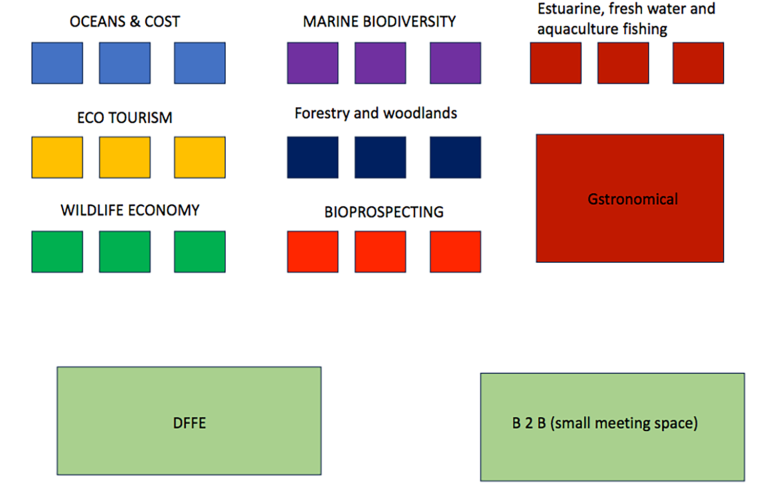
Areas for displays at the upcoming indaba on mega-landscapes. (Image: Supplied)
Included in the figure of R4,6 billion is R1,8 billion from 6,242 international clients who killed 36,500 animals in 2022 Since the local hunting market is unlikely to grow, the planned increase would need to come from international hunters. This will require an increase of 155% more international hunters to 15,900 hunters killing 93,000 animals. Where these animals will come from is not explained.
The strategy envisages an increase in the number of Big Five animals available for fair-chase trophy hunting, an expansion of recreational and traditional hunting, wild meat harvesting and fishing, and the increased use of indigenous plants, and of insects for food.
The plan says that until the international sale of ivory and rhino horn is favourable (though it’s unclear why the department thinks this will ever happen), domestic trade could be stimulated.
“For example, health clinics to administer traditional remedies using rhino horn for health tourists from the Far East or ivory carving done locally for sale and export for personal use.”
What is being suggested appears to be linked to the Game Meat Strategy published in 2022 which seeks to agriculturalise wild animals.
A document supporting the plan that was supplied following a request to the DFFE this week says game meat has not been efficiently utilised for livelihood and economic growth, and has been identified as an alternative, cheap and readily available source of protein, especially for rural communities.
“The implementation of the strategy will ensure safe and sustainable harvesting of game meat, job creation and rural economic development… There will be new business, investments, jobs and value chain opportunities that will have secondary benefits related to the commercialisation of this commodity. These benefits far outweigh the costs.”
Alarm bells
The plan puts forward a form of extractive conservation, based on the idea that what you consume you will conserve. This type of thinking is essentially a farming ethic, ranging from sacrificial animals being hunted to provide funds for the conservation of a species or biome, to cattle feedlots and chicken and pig batteries.
It makes sense in relation to a puzzling proposal in 2019 when there were attempts to list more than 30 species of wild animals, including lions, giraffes, white and black rhinos, lions and cheetahs, under the Animal Improvement Act. This would have effectively rendered them farm animals subject to manipulation and consumption. It was overturned following a court challenge by the Endangered Wildlife Trust.
Shortly afterwards, 98 more species were proposed to be listed under the Meat Safety Act, including rhinos, hippos, elephants and crocodiles. According to the Act, they could then be “slaughtered for food for human and animal consumption”. At the time, the reasons for these reclassifications by the Department of Agriculture, Land Reform and Rural Development were unclear, but they are now obvious.
The plan has rung alarm bells at environmental NGOs.
According to Dr Ross Harvey, the director of research at Good Governance Africa, a plan to commodify wildlife “ignores the biological reality that trophy hunting removes prime males (never ‘surplus’ males, which is a convenient myth). It also ignores robust research which shows that the opportunity costs of trophy hunting in SA render the practice unsustainable.
“All this comes on top of providing no proper time for public participation. This makes the whole thing look like a foregone conclusion that the government wants the public to rubber-stamp without really engaging.”
Taylor Tench, a policy analyst at the US Environmental Investigation Agency, said the idea of developing a market for domestic trade in animal parts such as carved ivory or rhino horn as traditional medicine for Asian tourists was particularly shocking. It would stimulate the export of objects and substances illegal under Cites regulations and which are merely aspirational and have no discernible medical value.
“If such markets and products were to take hold in South Africa,” he writes, “it would result in severe negative impacts for rhinos, elephants and potentially other species. The proposed creation of domestic markets for rhino horn and ivory targeted at international tourists contradicts — and would undermine — South Africa’s reputation as a destination for sustainable wildlife tourism.”
The environmental lawyers Cullinan & Associates, acting for the EMS Foundation, have served notice on the DFFE for a 45-day extension to submit comments on the plan, failing which it will take legal steps.
“A comment period of at least 30 days, but more often 60 days, is accepted as being the minimum to allow meaningful and effective public participation,” the notice says. “No reasons are given for deviating from accepted practice.”
The timeframe has also been questioned by Wildlife Ranching South Africa.
Trophy hunters
The plan appears to favour the conservation of wildlife and massively extends areas under a form of protection, which is a definite plus. But by embracing consumptive use it seems to cut across the considerable advances made by Environment Minister Barbara Creecy and her department regarding the welfare of wild animals, her stand against captive-bred lions, the progressive findings of the high-level panel on lions, elephants, rhinos and leopards, and the White Paper on Conservation and Sustainable Use of Biodiversity.
It would also make South Africa one of the world’s top destinations for trophy hunters at a time when that practice is coming under increasing disapproval internationally. This could have a negative impact on brand South Africa and international tourism.
There is also a problem with expecting hunting revenue to increase within the new mega landscapes when it is declining as a sport.
An article in Africa Geographic quoted research showing that between 1991 and 2016 the number of hunters in the US fell by 18.5%, from 14.1 million to 11.5 million. In France, it dropped by half in 40 years.
South Africa saw a 60.5% drop in eight years, from 16,594 in 2008 to 6,539 in 2016. The number of trophies exported fell from 5,049 in 2014 to 1,993 in 2018. Lion trophies during this time dropped from 1,160 to 259.
According to the EMS Foundation, “South Africa will be attempting to turn the country into a trophy hunting destination … for a privileged few trophy hunters.”
The plan also raises questions about the future of captive-bred lion farming, which Creecy has vowed to close down and has appointed a team to plan this. There are an estimated 10,000 to 12,000 lions on these farms. Will they be euthanised or offered to hunters within the new mega landscapes?
The proposal may be a reaction to huge pressure from the hunting fraternity, or incongruity between her department and the Department of Agriculture, which has been accused of dragging its heels on a draft Animal Welfare Act. There have been suggestions that it’s the wrong department to be doing this, particularly with regard to wild animals.
Connectivity
Much is made in the plan about ecosystem connectivity, the halting of species extinction and leveraging natural systems to alleviate rural poverty among formerly disadvantaged people. This would be funded, it says, through tourism, hunting, bioprospecting and funds from the government plus local and foreign grants.
It would also leverage public/private partnerships linked to communities for the rehabilitation of degraded land. The plan also envisages a Biodiversity Trust Fund for community conservation and development of resource use.
To do this, it says, would require the removal of barriers to entry into game ranching for emerging black entrepreneurs and an expansion of benefits to previously disadvantaged individuals and rural communities.
Unfortunately, the redistribution and protection of reclaimed areas and redistributed land has not fared well in South Africa and often devolves into squabbles between claimants and rural groups. It tends to be insufficiently policed and is often plundered.
A big problem with hunting — as many countries in Africa that allow it have found — is that it permits poaching to be laundered within the legal framework. As for bioprospecting, South Africa doesn’t have a police force knowledgeable or large enough to prevent it from leading to rare plant poaching. There has also been poor performance in the curbing of marine poaching. DM
Government trying to slam through plan that will result in massive exploitation of wildlife

A herd of elephants at the Numbi Gate of the Kruger National Park in Mbombela, Mpumalanga. (Photo: Gallo Images / Daily Maverick / Felix Dlangamandla)
By Don Pinnock | 18 Mar 2024
By Friday, 22 March, the public is expected to have commented on a detailed plan by the Department of Forestry, Fisheries and the Environment to massively exploit and monetise South Africa’s wildlife. The public was given just 14 days to respond.
______________________________________________________________________________________________________________________________
The Department of Forestry, Fisheries and the Environment (DFFE) has released a 48-page plan to create integrated “mega landscapes” on land and sea encompassing extensive areas where hunting, bioprospecting and tourism would monetise wild animals and plants for “consumptive use”.
To do this, the government will attempt to mobilise state and private resources, starting with an indaba in Gauteng from 24 to 26 March. The Birchwood Hotel and OR Tambo Conference Centre have been hired for the event at a cost of R3,698,859.
The plan was released on 8 March and gives the public until 22 March to comment, a 14-day deadline that many see as a box-ticking exercise to claim that the public has been consulted before the plan goes on show at the indaba.

Schematic for a government plant for the creation of mega-landscapes. (Image: Supplied)
The proposal is to grow areas under conservation — called mega living conservation landscapes — from 20 million hectares to 34 million hectares by 2040, an area equal to seven Kruger National Parks. Five mega landscapes are suggested, with proposals including:
- iSimangaliso/Ezemvelo/uMkhanyakude in KwaZulu/Natal;
- Waterberg/Limpopo River/Makapan Valley in Limpopo;
- Lekgalameetse/Wolkberg/Thabina in the Tzaneen area;
- Addo/Camdeboo Corridor and Grasslands National Park in the Eastern Cape;
- North West; and
- Northern Cape.
“Consumptive use” of wild animals within these landscapes is predicted by the plan to increase from R4.6-billion to R27.6-billion by 2036, bioprospecting and plant trade from R1.85-billion to R11.6-billion and marine and freshwater exploitation to rise by 10% a year. This represents a massive monetisation of South Africa’s wild ecosystems.

Areas for displays at the upcoming indaba on mega-landscapes. (Image: Supplied)
Included in the figure of R4,6 billion is R1,8 billion from 6,242 international clients who killed 36,500 animals in 2022 Since the local hunting market is unlikely to grow, the planned increase would need to come from international hunters. This will require an increase of 155% more international hunters to 15,900 hunters killing 93,000 animals. Where these animals will come from is not explained.
The strategy envisages an increase in the number of Big Five animals available for fair-chase trophy hunting, an expansion of recreational and traditional hunting, wild meat harvesting and fishing, and the increased use of indigenous plants, and of insects for food.
The plan says that until the international sale of ivory and rhino horn is favourable (though it’s unclear why the department thinks this will ever happen), domestic trade could be stimulated.
“For example, health clinics to administer traditional remedies using rhino horn for health tourists from the Far East or ivory carving done locally for sale and export for personal use.”
What is being suggested appears to be linked to the Game Meat Strategy published in 2022 which seeks to agriculturalise wild animals.
A document supporting the plan that was supplied following a request to the DFFE this week says game meat has not been efficiently utilised for livelihood and economic growth, and has been identified as an alternative, cheap and readily available source of protein, especially for rural communities.
“The implementation of the strategy will ensure safe and sustainable harvesting of game meat, job creation and rural economic development… There will be new business, investments, jobs and value chain opportunities that will have secondary benefits related to the commercialisation of this commodity. These benefits far outweigh the costs.”
Alarm bells
The plan puts forward a form of extractive conservation, based on the idea that what you consume you will conserve. This type of thinking is essentially a farming ethic, ranging from sacrificial animals being hunted to provide funds for the conservation of a species or biome, to cattle feedlots and chicken and pig batteries.
It makes sense in relation to a puzzling proposal in 2019 when there were attempts to list more than 30 species of wild animals, including lions, giraffes, white and black rhinos, lions and cheetahs, under the Animal Improvement Act. This would have effectively rendered them farm animals subject to manipulation and consumption. It was overturned following a court challenge by the Endangered Wildlife Trust.
Shortly afterwards, 98 more species were proposed to be listed under the Meat Safety Act, including rhinos, hippos, elephants and crocodiles. According to the Act, they could then be “slaughtered for food for human and animal consumption”. At the time, the reasons for these reclassifications by the Department of Agriculture, Land Reform and Rural Development were unclear, but they are now obvious.
The plan has rung alarm bells at environmental NGOs.
According to Dr Ross Harvey, the director of research at Good Governance Africa, a plan to commodify wildlife “ignores the biological reality that trophy hunting removes prime males (never ‘surplus’ males, which is a convenient myth). It also ignores robust research which shows that the opportunity costs of trophy hunting in SA render the practice unsustainable.
“All this comes on top of providing no proper time for public participation. This makes the whole thing look like a foregone conclusion that the government wants the public to rubber-stamp without really engaging.”
Taylor Tench, a policy analyst at the US Environmental Investigation Agency, said the idea of developing a market for domestic trade in animal parts such as carved ivory or rhino horn as traditional medicine for Asian tourists was particularly shocking. It would stimulate the export of objects and substances illegal under Cites regulations and which are merely aspirational and have no discernible medical value.
“If such markets and products were to take hold in South Africa,” he writes, “it would result in severe negative impacts for rhinos, elephants and potentially other species. The proposed creation of domestic markets for rhino horn and ivory targeted at international tourists contradicts — and would undermine — South Africa’s reputation as a destination for sustainable wildlife tourism.”
The environmental lawyers Cullinan & Associates, acting for the EMS Foundation, have served notice on the DFFE for a 45-day extension to submit comments on the plan, failing which it will take legal steps.
“A comment period of at least 30 days, but more often 60 days, is accepted as being the minimum to allow meaningful and effective public participation,” the notice says. “No reasons are given for deviating from accepted practice.”
The timeframe has also been questioned by Wildlife Ranching South Africa.
Trophy hunters
The plan appears to favour the conservation of wildlife and massively extends areas under a form of protection, which is a definite plus. But by embracing consumptive use it seems to cut across the considerable advances made by Environment Minister Barbara Creecy and her department regarding the welfare of wild animals, her stand against captive-bred lions, the progressive findings of the high-level panel on lions, elephants, rhinos and leopards, and the White Paper on Conservation and Sustainable Use of Biodiversity.
It would also make South Africa one of the world’s top destinations for trophy hunters at a time when that practice is coming under increasing disapproval internationally. This could have a negative impact on brand South Africa and international tourism.
There is also a problem with expecting hunting revenue to increase within the new mega landscapes when it is declining as a sport.
An article in Africa Geographic quoted research showing that between 1991 and 2016 the number of hunters in the US fell by 18.5%, from 14.1 million to 11.5 million. In France, it dropped by half in 40 years.
South Africa saw a 60.5% drop in eight years, from 16,594 in 2008 to 6,539 in 2016. The number of trophies exported fell from 5,049 in 2014 to 1,993 in 2018. Lion trophies during this time dropped from 1,160 to 259.
According to the EMS Foundation, “South Africa will be attempting to turn the country into a trophy hunting destination … for a privileged few trophy hunters.”
The plan also raises questions about the future of captive-bred lion farming, which Creecy has vowed to close down and has appointed a team to plan this. There are an estimated 10,000 to 12,000 lions on these farms. Will they be euthanised or offered to hunters within the new mega landscapes?
The proposal may be a reaction to huge pressure from the hunting fraternity, or incongruity between her department and the Department of Agriculture, which has been accused of dragging its heels on a draft Animal Welfare Act. There have been suggestions that it’s the wrong department to be doing this, particularly with regard to wild animals.
Connectivity
Much is made in the plan about ecosystem connectivity, the halting of species extinction and leveraging natural systems to alleviate rural poverty among formerly disadvantaged people. This would be funded, it says, through tourism, hunting, bioprospecting and funds from the government plus local and foreign grants.
It would also leverage public/private partnerships linked to communities for the rehabilitation of degraded land. The plan also envisages a Biodiversity Trust Fund for community conservation and development of resource use.
To do this, it says, would require the removal of barriers to entry into game ranching for emerging black entrepreneurs and an expansion of benefits to previously disadvantaged individuals and rural communities.
Unfortunately, the redistribution and protection of reclaimed areas and redistributed land has not fared well in South Africa and often devolves into squabbles between claimants and rural groups. It tends to be insufficiently policed and is often plundered.
A big problem with hunting — as many countries in Africa that allow it have found — is that it permits poaching to be laundered within the legal framework. As for bioprospecting, South Africa doesn’t have a police force knowledgeable or large enough to prevent it from leading to rare plant poaching. There has also been poor performance in the curbing of marine poaching. DM
"Education is the most powerful weapon which you can use to change the world." Nelson Mandela
The desire for equality must never exceed the demands of knowledge
The desire for equality must never exceed the demands of knowledge
- Lisbeth
- Site Admin
- Posts: 67563
- Joined: Sat May 19, 2012 12:31 pm
- Country: Switzerland
- Location: Lugano
- Contact:
Re: Biodiversity
"Education is the most powerful weapon which you can use to change the world." Nelson Mandela
The desire for equality must never exceed the demands of knowledge
The desire for equality must never exceed the demands of knowledge


